Two different facile and efficient approaches for the synthesis of various N-arylacetamides via N-acetylation of arylamines and straightforward one-pot reductive acetylation of nitroarenes promoted by recyclable CuFe2O4 nanoparticles in water
Abstract
Two simple, efficient, and environmentally benign protocols for the synthesis of various N-arylacetamides via N-acetylation of arylamines and straightforward one-pot reductive acetylation of aromatic nitro compounds promoted by CuFe2O4 nanoparticles in water at reflux have been developed. The prepared CuFe2O4 MNPs are well known and fully characterized by various techniques. Furthermore, the CuFe2O4 NPs easily separated from the reaction environment using an external magnetic field and can be reused for several times without significant loss of its activity for both mentioned reactions.
1 Introduction
Performing organic reactions into the green solvents especially water is very favorable for academic researchers and industrial chemical companies due to its many desirable features such as low-cost, non-toxicity, safety, abundantly and also environmentally friendless compared with organic solvents [1, 2, 3, 4, 5, 6, 7, 8, 9, 10].
In recent years, construction of amide linkages is one of the valuable reactions in organic synthesis because of their extensive applications in various area such as peptide synthesis, agrochemicals, polymers, functional materials, dyes, fragrances and also existence in pharmaceuticals (Figure 1) and natural products (Figure 2) [11, 12, 13, 14, 15, 16, 17, 18, 19, 20, 21, 22, 23, 24, 25]. Due to the importance of amide compounds, developing simple, practical, environmentally benign, cost- and time-effective manners for their synthesis is very valuable and necessary. Undoubtedly, acetylation of arylamines is a very simple approach for the preparation of amides which is widely used in chemistry labs and chemical industry [26]. Therefore, the development of this mentioned method is justifiable. It is worthwhile to note that aromatic nitro compounds are much cheaper than arylamines in terms of price and one of the most important substrates for the preparation of arylamines via reduction process. So, designing new protocols for the synthesis of amides via straightforward one-pot reductive acetylation of aromatic nitro compounds without isolation of the arylamine intermediates is very interesting. In this regard, it should be noted that one-pot multicomponent reactions (MCRs) are remarkable instruments for versatile preparation of a wide diversity of organic compounds especially biologic active molecules which have advantages such as high atom economy, escape of time-consuming protection-deprotection steps, and environmentally friendliness, making them absolutely better than classical multistep synthetic pathways [27, 28, 29, 30, 31, 32, 33, 34, 35, 36, 37].
Notably, in recent years, spinel ferrite nanoparticles with the general formula MFe2O4, where M(II) is a d-block transition metal (such as Mn, Co, Ni, Cu, Zn) have been in the vanguard of nanoscience and nanotechnology due to their unique specifications like nanometer size, high saturation magnetization, large surface area to volume ratio, high electric resistivity, low eddy current loss, very good optical properties in the visible region and also their extensive applications in sensors, memory storage devices, magnetically controlled drug delivery, hyperthermia in the treatment of cancer diseases, medical diagnostics, magnetic resonance image (MRI) enhancement, telecommunication, pigments, and catalysis [38, 39, 40, 41, 42, 43, 44, 45]. Furthermore, compared with iron oxides, spinel ferrites provide flexibility to control both crystal structures and magnetic properties by choosing different non-iron metals in spinel ferrite backbone and controlling their molar concentrations. Among various type of spinel ferrite magnetic nanoparticles (MNPs), CuFe2O4 nanocomposite, in addition to numerous applications, has shown satisfactory performance as the recyclable catalyst in various organic transformations such as synthesis of heterocyclic compounds [46, 47, 48, 49, 50, 51, 52], Ullmann C-O coupling reaction [53], direct synthesis of chemical structures containing both phenol ester and benzothiazole moieties via dehydrogenative coupling reactions [54], reduction of p-nitrophenol [55], one-pot odorless carbon-sulfur bond formation reactions [56], directed phenol/formamide coupling [57], synthesis of diaryl/aryl alkyl sulfides via cross-coupling process [58], S-arylation of thioureas by aryl halides [59], one-pot four-component Dakin-West reaction (synthesis of β-acetamido ketones) [60], Friedel-Crafts acylation [61], N-arylation of heterocycles [62], direct C-H amination of benzothiazoles [63], oxidative hydroxylation of arylboronic acids [64], palm oil methanolysis [65], oxidation of benzyl alcohol [66], synthesis of unnatural arundines [67], N-arylation of indole and imidazole with aryl halide [68], and so on.
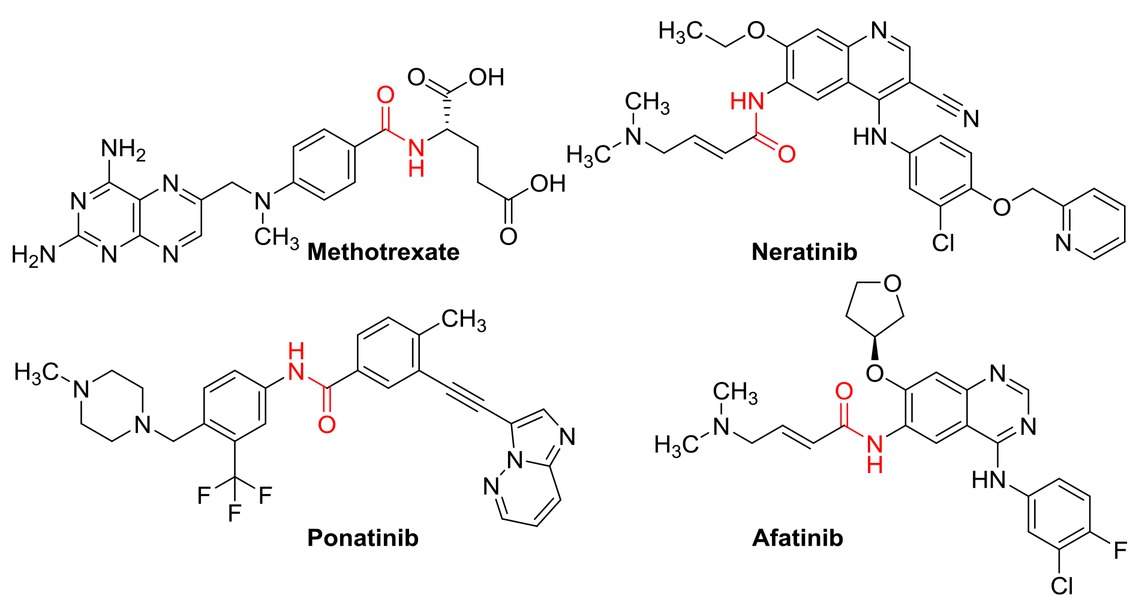
Representative examples of amide-containing drugs.
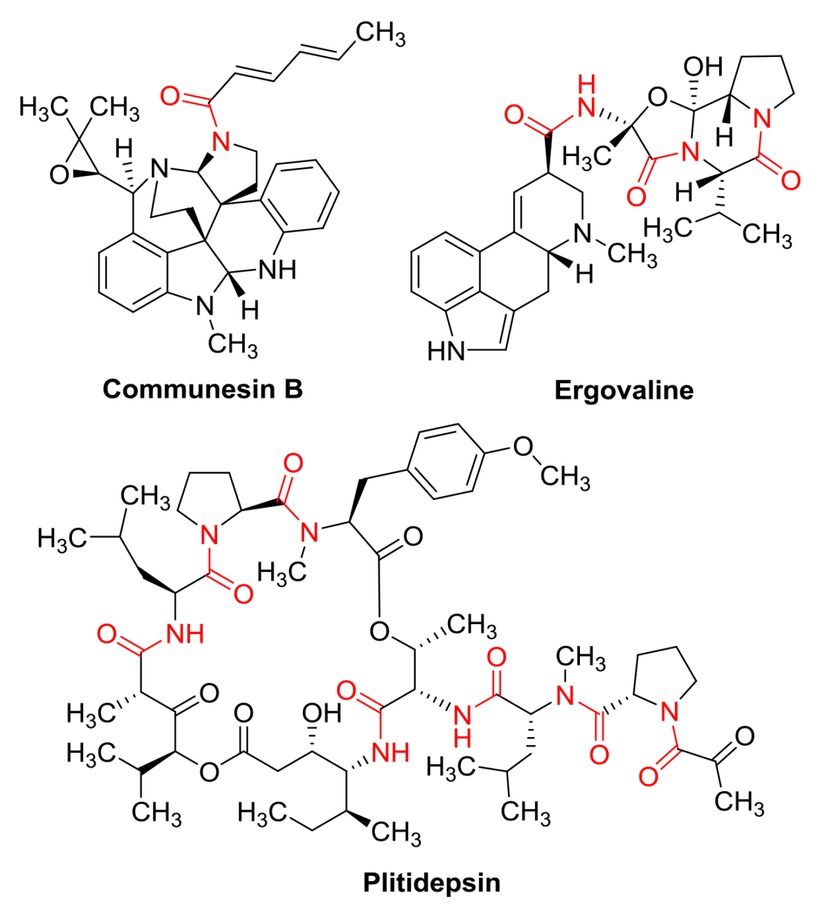
Examples of amide-containing natural products.
In continuation of our research programs on various type of organic reactions [67, 68, 69, 70, 71], especially on the simple methodologies for the preparation of N-arylacetamides [72, 73, 74, 75], we wish to report two different facile and efficient approaches for the synthesis of divers N-arylacetamides via N-acetylation of arylamines and straightforward one-pot reductive acetylation of nitroarenes promoted by recyclable CuFe2O4 MNPs in water at reflux (Scheme 1).
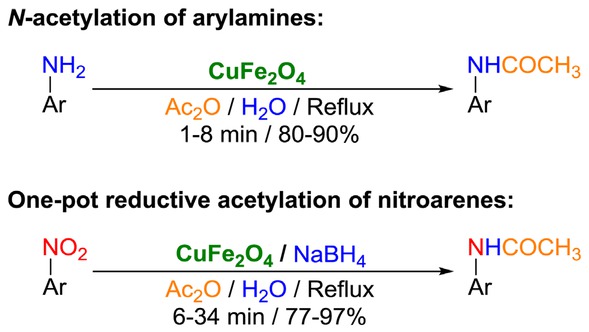
Two different facile and efficient approaches for the synthesis of various N-arylacetamides promoted by CuFe2O4 MNPs.
2 Results and discussion
2.1 Preparation and characterization of the CuFe2O4 magnetically nanocomposite
First of all, CuFe2O4 magnetically nanoparticles (MNPs) prepared through the simple procedure which was reported by Jia and co-workers [76]. Notably, the obtained CuFe2O4 nanocomposite fully characterized by various techniques including Fourier transform infrared (FT-IR) spectroscopy, X-ray diffraction (XRD), scanning electron microscopy (SEM), transmission electron microscopy (TEM), energy-dispersive X-ray (EDX) spectroscopy, inductively coupled plasma-optical emission spectrometry (ICP-OES), vibrating sample magnetometer (VSM) and also BET-BJH analyses.
In the FT-IR spectrum of the prepared CuFe2O4 (Figure 3), the absorption band at 586.8 cm-1 is ascribed to the stretching vibration frequency of octahedral site, and the absorption band at 405.8 cm-1 is related to the tetrahedral site.
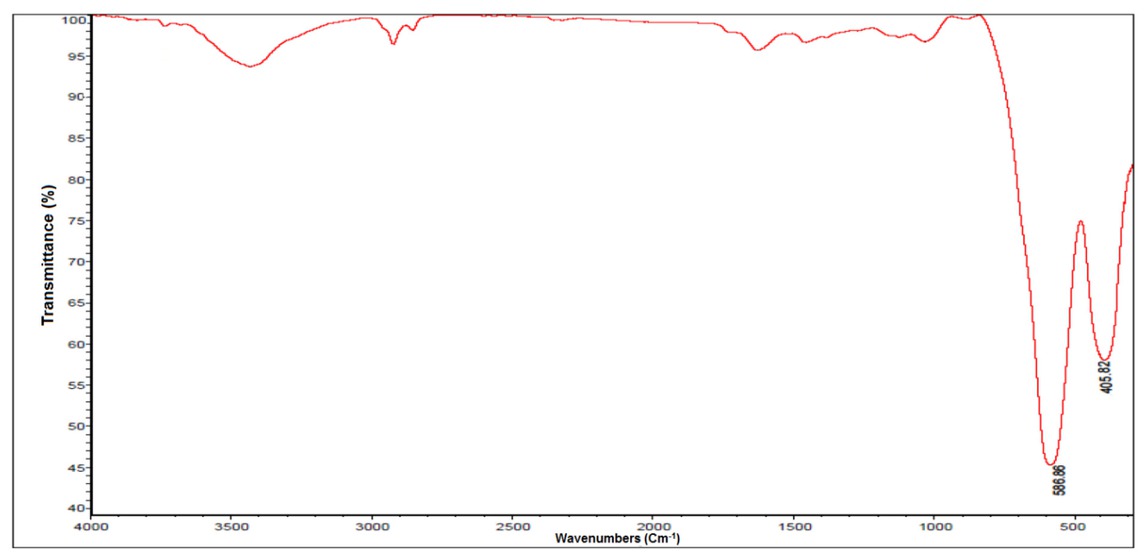
FT-IR spectrum of the CuFe2O4 MNPs.
As can be seen from Figure 4, the XRD pattern of the mentioned CuFe2O4 nanocomposite reveals that all the peaks matched with the standard XRD pattern of CuFe2O4 (JCPDS card no. 34-0425). Furthermore, the sharp peaks which existed in the XRD pattern of the synthesized copper ferrite MNPs prove the crystalline nature of the mentioned nanocomposite.
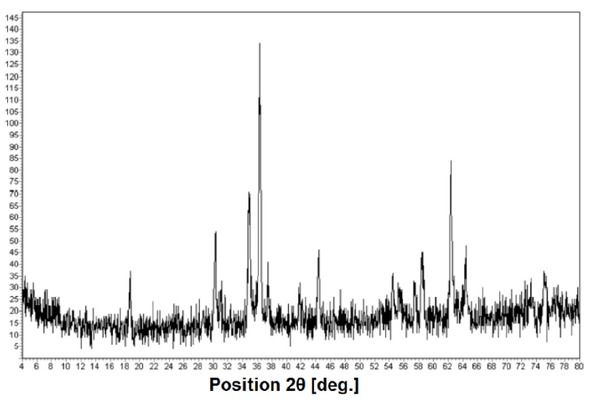
XRD spectrum of the CuFe2O4 MNPs.
According to the SEM (Figure 5) and TEM (Figure 6) images, the particles of the synthesized CuFe2O4 nanocomposite are in the nanometric range along with irregular morphology.
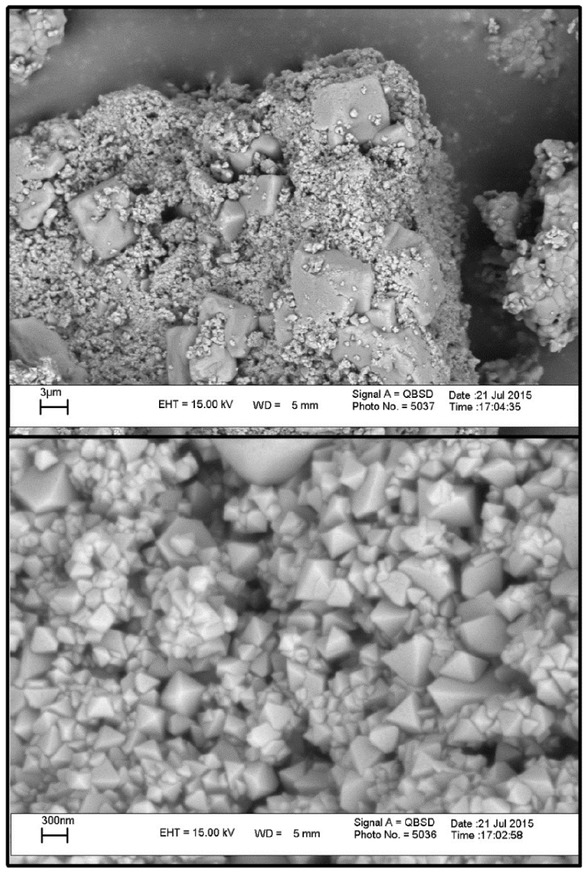
SEM images of the CuFe2O4 MNPs.
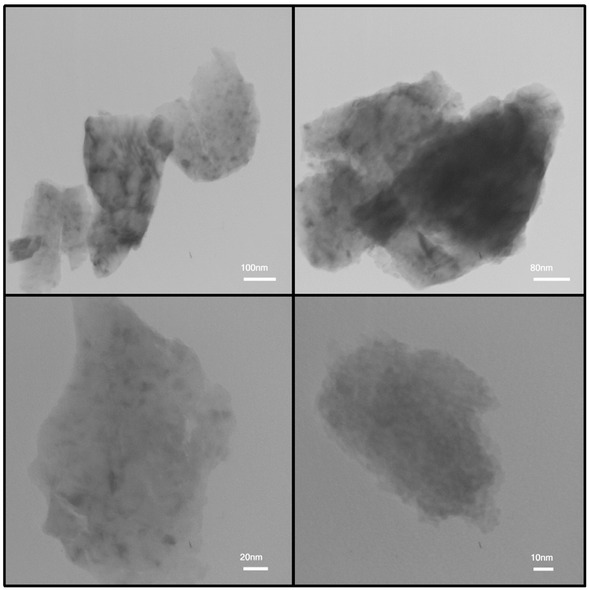
TEM images of the CuFe2O4 MNPs.
The EDX spectrum of the CuFe2O4 shows that Cu, Fe, and O are present in the structure of the prepared nanocomposite (Figure 7). Also, the ICP-OES analysis showed that the amounts of Cu, Fe, and O in the CuFe2O4 nanocomposite were 22.52%, 46.71%, and 30.77%, respectively.
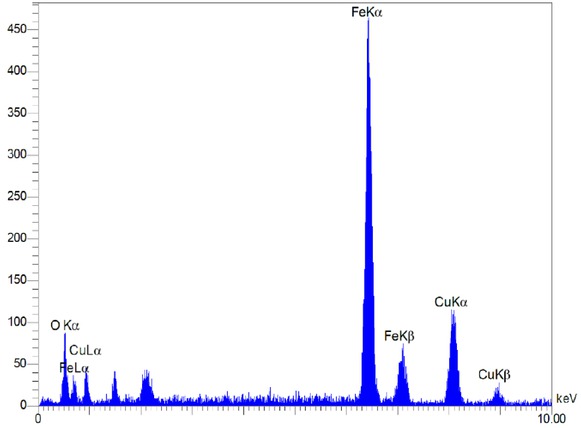
EDX spectrum of the CuFe2O4 MNPs.
The obtained saturation magnetization value (Ms = 38 emu·g-1) and the shape of the illustrated pattern show that the prepared nanocatalyst has a ferromagnetic characteristic for a convenient magnetic separation (Figure 8).
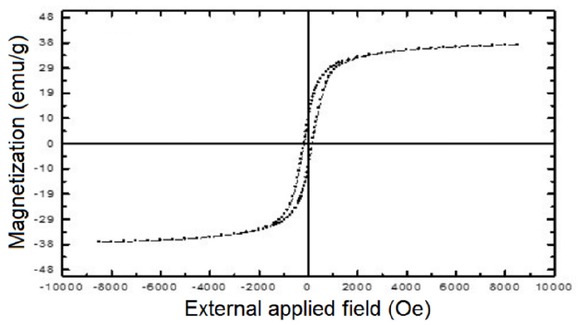
VSM spectrum of the CuFe2O4 MNPs.
The nitrogen adsorption-desorption isotherm of the CuFe2O4 NPs was measured (Figure 9). As shown in Figure 9, the prepared nanocomposite exhibited type III isotherm, indicating micro-pore nature of the CuFe2O4. Also, according to the BET equation, the specific surface area (SSA) and pore volume value (PVV) of the mentioned nanocomposite calculated (SSA = 5.46 m2·g-1 and PVV = 0.0077 cm3·g-1).
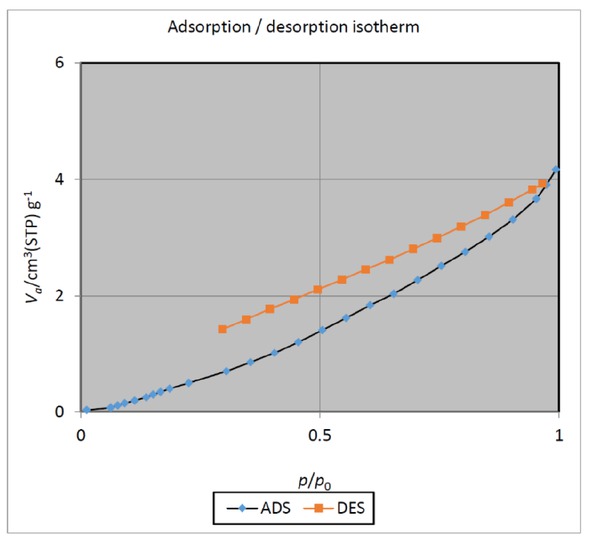
N2 adsorption-desorption isotherm for the CuFe2O4 MNPs.
Besides, the distribution of pore size is 1.88 nm based on the Barrett-Joyner-Halenda (BJH) analysis.
2.2 N-acetylation of arylamimes promoted by CuFe2O4 MNPs
Indisputable, amine acetylation is one of the most extensively used reactions in organic chemistry and is often used in the preparation of amide compounds and also protection of –NH functional group. N-acetylation of amine is generally accomplished using acetic anhydride or acetyl chloride as acetyl donors in the presence of an acidic or basic catalyst in the organic medium. Up to now, several methods have been reported for the mentioned reaction. Nevertheless, some of these methods along with some merits have one or more drawbacks such as the use of expensive and harmful reagents, solvents or catalysts, harsh reaction conditions, low yield of products and (or) lengthy reaction times and so on [77, 78, 79, 80, 81, 82, 83, 84, 85, 86, 87, 88, 89, 90, 91, 92, 93, 94, 95, 96]. In this regard, we decided to introduce a simple, efficient, green, cost-and time-effective protocol for the N-acetylation of arylamines.
At the outset of experimental work, the reaction of aniline with acetic anhydride (Ac2O) as an acetylating agent was chosen as a model reaction to confirm the feasibility of our strategy and optimize the reaction conditions (Table 1). At first, we evaluated the effect of various solvents such as MeOH, EtOH, THF, CH3CN, and EtOAc, on the model reaction utilizing a different molar ratio of CuFe2O4 MNPs. As shown in entry 9 of Table 1, the best condition for this mentioned reaction was the use of 1 mmol Ac2O and also 0.3 mmol of CuFe2O4 MNPs in water at reflux. Furthermore, to examine the reaction scope, various arylamines possessing electron-withdrawing (EWD) and electron-donating groups (EDG) were reacted with Ac2O under the optimized reaction conditions to give the corresponding N-arylacetamides. Based on the data shown in Table 2, all the desired products were prepared in good to excellent yields. It is worth noting the chemoselectivity observed for the arylamines containing benzylic alcohol group (Table 2, entry 13 and 14).
Optimization experiments for the N-acetylation of aniline to acetanilide.
 | ||||||
|---|---|---|---|---|---|---|
| Entry | CuFe2O4 (mmol) | Ac2O (mmol) | Solvent | Time | Conv. (%) | |
| 1 | 1 | 3 | MeOH | 2 h | N.R. | |
| 2 | 1 | 3 | EtOH | 2 h | N.R. | |
| 3 | 1 | 3 | THF | 2 h | N.R. | |
| 4 | 1 | 3 | CH3CN | 2 h | N.R. | |
| 5 | 1 | - | EtOAc | 2 h | N.R. | |
| 6 | 1 | 3 | EtOAc | 2 h | 40 | |
| 7 | 1 | 1 | H2O | 1 min | 100 | |
| 8 | 0.5 | 1 | H2O | 1 min | 100 | |
| 9 | 0.3 | 1 | H2O | 1 min | 100 | |
| 10 | 0.2 | 1 | H2O | 2 min | 100 | |
N.R. = No reaction (Conv. = 0)
N-acetylation of arylamines using Ac2O promoted by CuFe2O4 MNPs in water.
 | |||||
|---|---|---|---|---|---|
| Entry | Substrate | Product | Molar Ratioa | Time (min) | Yieldb (%) |
| 1 | 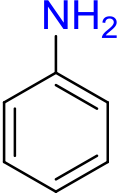 | 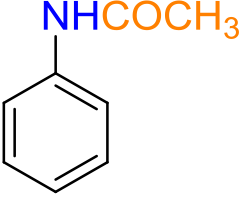 | 1:0.3:1 | 1 | 90 |
| 2 | 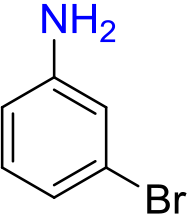 | 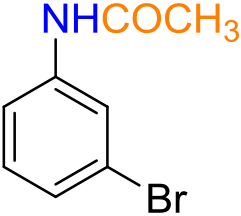 | 1:0.3:1 | 4 | 85 |
| 3 | 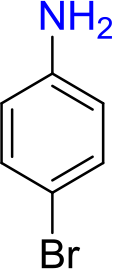 | 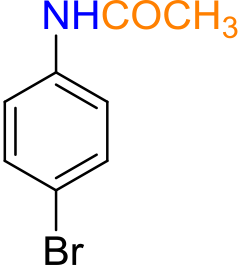 | 1:0.3:1 | 4 | 86 |
| 4 | 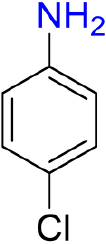 | 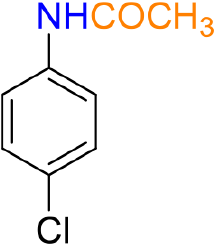 | 1:0.3:1 | 4 | 86 |
| 5 | 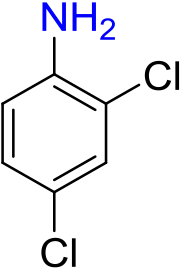 | 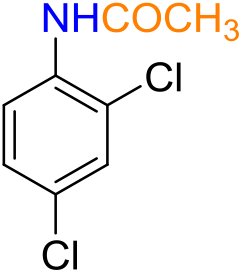 | 1:0.3:2 | 3 | 89 |
| 6 | 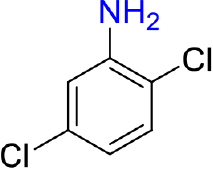 | 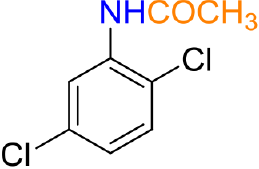 | 1:0.3:2 | 3 | 89 |
| 7 | 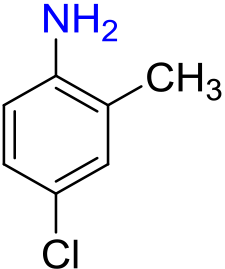 | 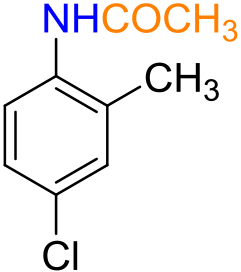 | 1:0.3:1 | 5 | 87 |
| 8 | 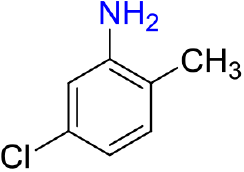 | 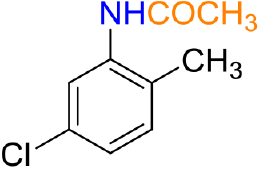 | 1:0.3:1.5 | 5 | 87 |
| 9 | 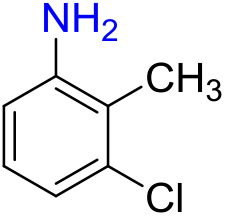 | 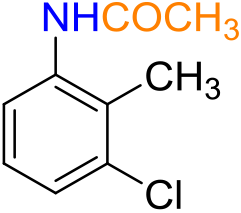 | 1:0.3:1.5 | 3 | 85 |
| 10 | 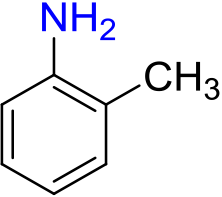 | 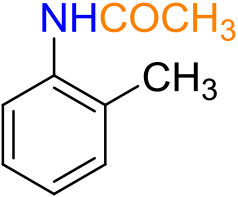 | 1:0.3:1 | 4 | 86 |
| 11 | 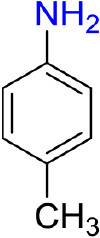 | 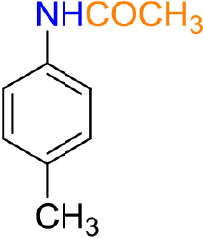 | 1:0.3:1 | 3 | 88 |
| 12 | 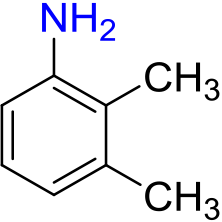 | 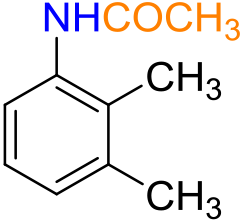 | 1:0.3:1 | 3 | 86 |
| 13 | 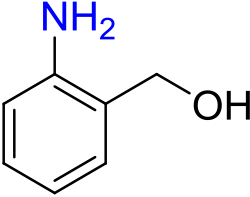 | 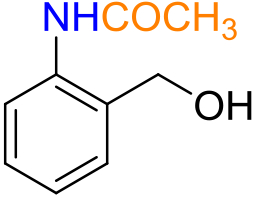 | 1:0.3:1.5 | 4 | 80 |
| 14 | 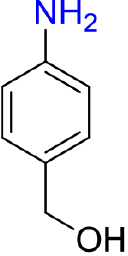 | 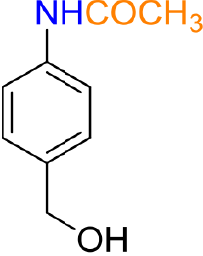 | 1:0.3:1.5 | 2 | 80 |
| 15 | 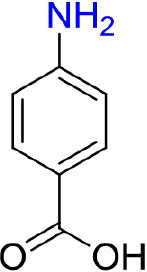 | 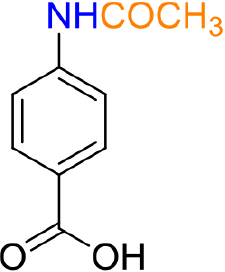 | 1:0.3:1.5 | 8 | 80 |
| 16 | 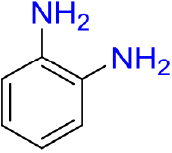 | 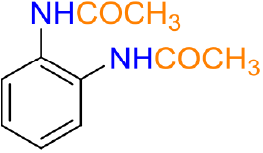 | 1:0.3:2 | 3 | 89 |
| 17 | 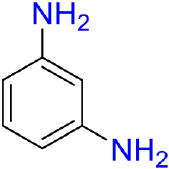 | 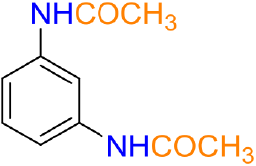 | 1:0.3:2 | 3 | 87 |
| 18 | 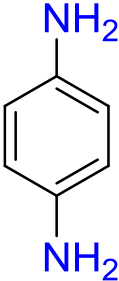 | 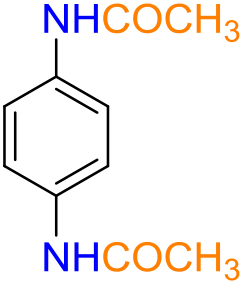 | 1:0.3:2 | 3 | 89 |
a Substrate:CuFe2O4:Ac2O.
b Yields refer to isolated pure products.
2.3 One-pot reductive acetylation of aromatic nitro compounds promoted by CuFe2O4 MNPs
In order to optimize reaction conditions, the transformation of nitrobenzene (PhNO2) as a model compound to acetanilide was studied through a primary reduction of PhNO2 with sodium borohydride (NaBH4) using CuFe2O4 as recyclable promoter followed by acetylation with Ac2O in a one-pot procedure without isolation of aniline intermediate under different reaction conditions. The reductive acetylation of PhNO2 under mentioned system in protic and aprotic solvents such as MeOH, EtOH, THF, CH3CN, and EtOAc (Table 3, entries 1-5) and also under solvent-free condition (Table 3, entry 6) did not take place any more. Interestingly, further investigations demonstrated that H2O was the best solvent of choice (Table 3, entries 7-11) and using a molar equivalent of 1:1:2:1 for PhNO2, CuFe2O4, NaBH4 and also Ac2O, respectively, was an optimum for the complete mentioned one-pot reaction (Table 3, entry 7). More examinations also exhibited that completion of the model reaction with other amounts of the CuFe2O4 (0.7, 0.5, 0.3, and 0.2 mmol) was also accessible (Table 3, entries 8, 9, 10, and 11). However, prolonging the reaction time impeded using them as the optimum amount.
Optimization experiments for the one-pot reductive acetylation of nitrobenzene to acetanilide promoted by CuFe2O4 MNPs.
 | ||||||
|---|---|---|---|---|---|---|
| Entry | NaBH4 (mmol) | CuFe2O4 (mmol) | Ac2O (mmol) | Solvent | Time | Conv. (%) |
| 1 | 3 | 1 | 3 | MeOH | 2 h | N.R. |
| 2 | 3 | 1 | 3 | EtOH | 2 h | N.R. |
| 3 | 3 | 1 | 3 | THF | 2 h | N.R. |
| 4 | 3 | 1 | 3 | CH3CN | 2 h | N.R. |
| 5 | 3 | 1 | - | EtOAc | 2 h | N.R. |
| 6 | 3 | 1 | 3 | - | 2 h | N.R. |
| 7 | 2 | 1 | 1 | H2O | 11 min | 100 |
| 8 | 2 | 0.7 | 1 | H2O | 24 min | 100 |
| 9 | 2 | 0.5 | 1 | H2O | 46 min | 100 |
| 10 | 2 | 0.3 | 1 | H2O | 49 min | 100 |
| 11 | 2 | 0.2 | 1 | H2O | 52 min | 100 |
| 12 | 2 | 1 | 0.5 | H2O | 45 min | 50 |
N.R. = No reaction (Conv. = 0)
Having established the optimal reaction conditions, we investigated the substrate scope of this one-pot transformation using various aromatic nitro compounds. The obtained results are summarized in Table 4. As seen, all reactions were carried out successfully in H2O within 6-34 min, and the corresponding N-arylacetamides were obtained in good to excellent yields.
One-pot reductive acetylation of aromatic nitro compounds promoted by CuFe2O4 MNPs.
 | |||||
|---|---|---|---|---|---|
| Entry | Substrate | Product | Molar ratioa | Time (min) | Yieldb (%) |
| 1 | 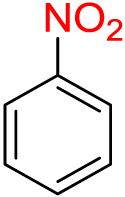 | 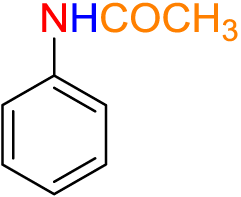 | 1:2:1:1 | 11 | 97 |
| 2 | 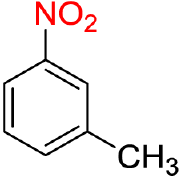 | 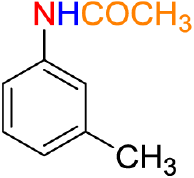 | 1:2:1:1 | 14 | 90 |
| 3 | 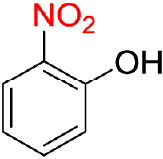 | 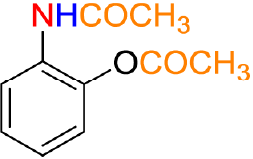 | 1:3:1:2 | 32 | 87 |
| 4c | 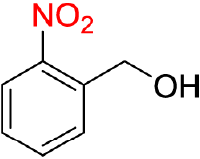 | 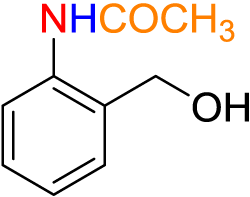 | 1:3.5:1.5 | 22 | 87 |
| 5c | 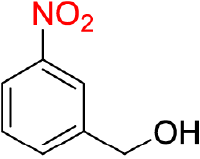 | 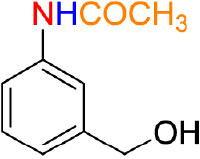 | 1:2:1:2 | 22 | 85 |
| 6 | 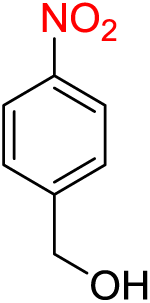 | 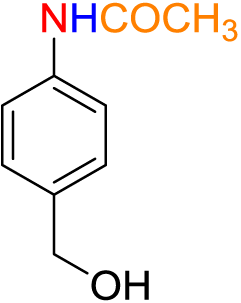 | 1:2:1:1.5 | 32 | 88 |
| 7c | 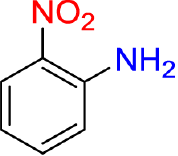 | 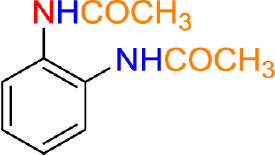 | 1:3:1:1 | 29 | 80 |
| 8c | 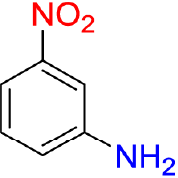 | 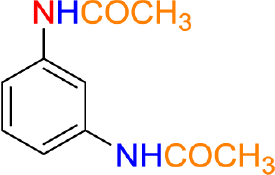 | 1:3:1:1 | 33 | 88 |
| 9c | 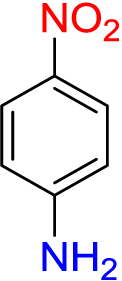 | 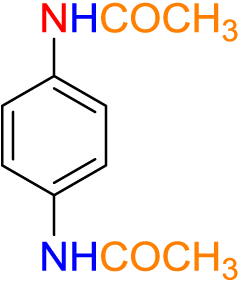 | 1:3:1:2 | 33 | 89 |
| 10c | 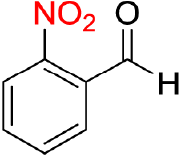 | 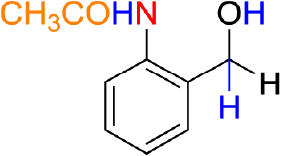 | 1:3:1:1 | 6 | 89 |
| 11 | 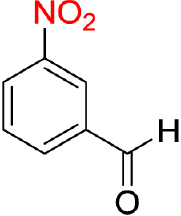 | 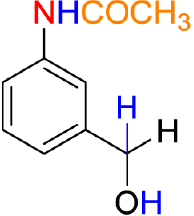 | 1:3:1:2 | 11 | 87 |
| 12c | 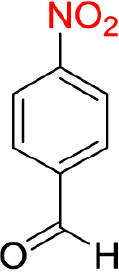 | 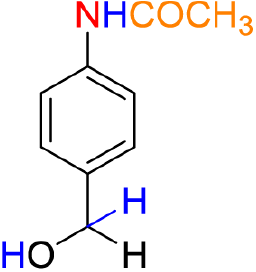 | 1:3:1:1 | 17 | 89 |
| 13c | 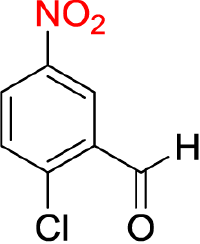 | 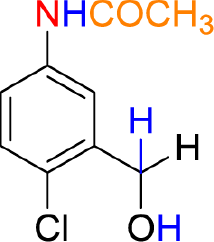 | 1:2:1:1.5 | 12 | 84 |
| 14c | 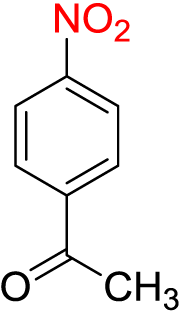 | 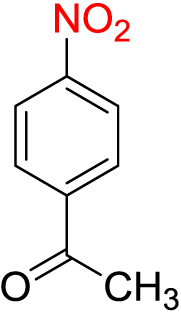 | 1:4:1:2 | 24 | 80 |
| 15c | 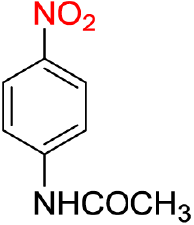 | 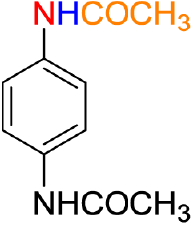 | 1:2.5:1:1 | 27 | 80 |
| 16c | 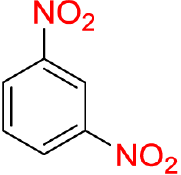 | 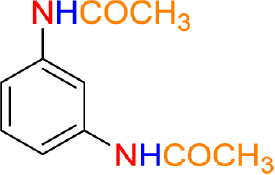 | 1:3:1:2 | 34 | 77 |
| 17 | 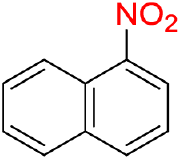 | 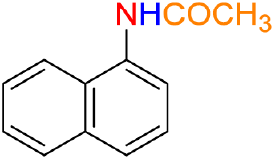 | 1:2:1:1 | 27 | 78 |
a Substrate:NaBH4:CuFe2O4:Ac2O.
b Yields refer to isolated pure products.
c In these reactions, NaBH4 was added portion-wisely.
More examinations showed that the chemoselective reductive acetylation of nitro group versus alcohol was successfully accessible. For example, reductive acetylation of 4-nitroabenzylalcohol to 4-acetamidobenzyl alcohol was carried out in 88% yield (Table 4, entry 6). In the case of nitrobenzaldehydes and nitroacetophenones, the same behavior was observable. In which, the nitro group was reduced and acetylated to acetamide, however, the carbonyl moieties were reduced to alcoholic function without acetylation (Table 4, entries 10-14). Molecules with the complexity of nitro and phenolic groups did not show any selectivity, and both of the functional groups were acetylated with the same reactivity. This fact was shown with reductive acetylation of o-nitrophenol to the corresponding 2-acetamidophenyl acetate (Table 4, entry 3). Table 4, entry 16 represents this protocol was also efficient for reductive acetylation of dinitro compounds using 1:3:2 molar equivalents of the CuFe2O4, NaBH4, and Ac2O respectively, in H2O at reflux.
Notably, the exact mechanism for the one-pot reductive acetylation reaction of nitroarenes in the presence of CuFe2O4 as a simple and efficient promoter is not known. But, based on our observations and literature survey [71,74, 75], a plausible reaction mechanism for this reaction is presented in Scheme 2. Firstly, nitroarene and hydrogen which is obtained from the reaction of NaBH4 and water absorbed on the surface of CuFe2O4 NPs. After completion of the reduction process which was accompanied by the elimination of two molecules of water, generated arylamine intermediate attacked to Ac2O (which was activated by CuFe2O4) caused the formation of desired amide compound along with carboxylic acid as an only side product.
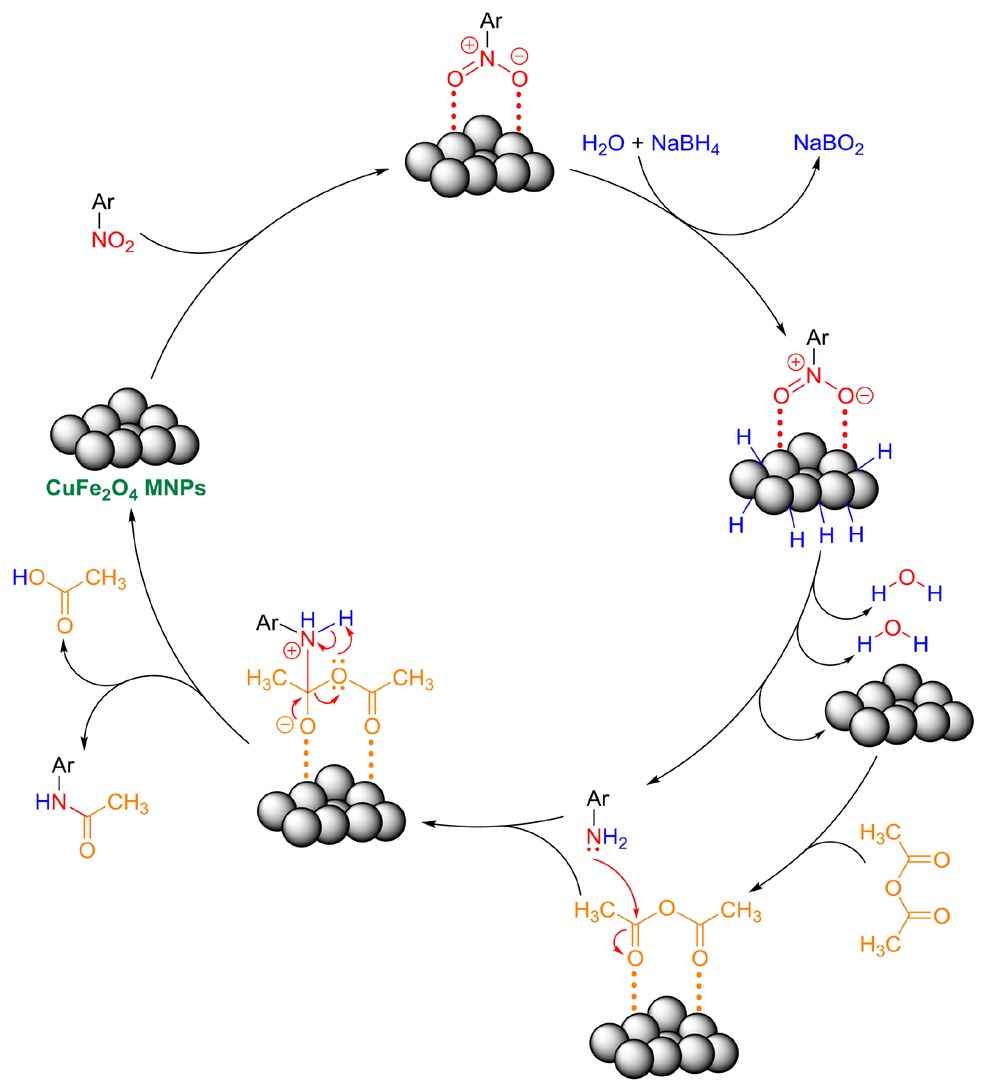
Plausible mechanism for the one-pot reductive acetylation of nitroarenes promoted by CuFe2O4 MNPs.
2.4 Reusability
The recoverability and reusability of the CuFe2O4 NPs were studied using the N-acetylation of aniline and also one-pot reductive acetylation of nitrobenzene reactions. After completion of the reaction, the catalyst separated by an external magnet and reused for the subsequent runs without significant loss of its catalytic activity (Figures 10 and 11).
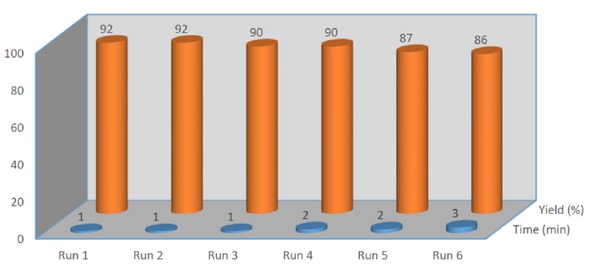
Reusability of the CuFe2O4 MNPs in the N-acetylation of aniline.
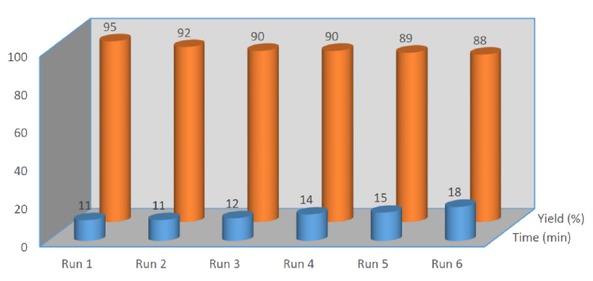
Reusability of the CuFe2O4 MNPs in the one-pot reductive acetylation of nitrobenzene.
3 Experimental
3.1 Preparation of the CuFe2O4 MNPs
CuFe2O4 MNPs were synthesized based on a previously reported method by Jia and co-workers [76]. First of all, copper(II) acetate, iron(III) nitrate, sodium hydroxide, and sodium chloride were mixed in a molar ratio 1:2:8:2 and grounded in a simple agate mortar and pestle. After about 50 min, the resultant mixture was washed with deionized water several times. After removal of sodium chloride by washing, the wet nanocomposite was dried for 2 h at 80°C. Finally, the powders were calcinated for 2 h at 300, 500, 600, 700, 800, and 900°C to obtain CuFe2O4 MNPs.
3.2 General experimental procedure for the synthesis of N-arylacetamides via N-acetylation of arylamines
To the synthesis of N-phenylacetamide as a representative example, a mixture of aniline (1 mmol, 0.093 g) and H2O (3 mL) was prepared in a round-bottom flask (15 mL) which equipped with a magnetic stirrer. Then, ferromagnetic CuFe2O4 (0.3 mmol, 0.072 g) was added into the reaction flask, and the resulting mixture was stirred at reflux. Subsequently, Ac2O (1 mmol, 0.102 g) was added to the prepared mixture followed by stirring for 1 min at the same temperature conditions. Then, the mixture was cooled to room temperature, and the CuFe2O4 was separated by a magnet from the reaction environment. Then, the reaction mixture was extracted with ethyl acetate (3 × 5 mL). The organic layers were combined and dried over anhydrous Na2SO4. Finally, evaporation of the solvent under reduced pressure afforded the pure N-phenylacetamide which was characterized by FT-IR, 1H NMR, and 13C NMR spectroscopy techniques.
3.3 General procedure for the synthesis of N-arylacetamides via one-pot reductive acetylation of aromatic nitro compounds
As an example, nitrobenzene (1 mmol, 0.123 g) was dissolved in 2 mL of H2O in a 15 mL round-bottom flask which equipped with a magnetic stirrer. Then, CuFe2O4 (1 mmol, 0.237 g) was added, and the mixture was stirred. Then, NaBH4 (2 mmol, 0.075 g) was added, and the resulting mixture was stirred under reflux conditions for 10 min. Completion of the reduction reaction was monitored by TLC using n-CCl4:Et2O (5:2) as an eluent. Afterward, acetic anhydride (1 mmol, 0.102 g) was added to the reaction mixture followed by stirring for an additional 1 min at the same temperature conditions. Afterward, the mixture was cooled to room temperature, and the mentioned nanocomposite was separated by a magnet from the reaction environment. The reaction mixture was extracted with ethyl acetate (3 × 5 mL). The organic layers were combined and dried over anhydrous Na2SO4. Finally, evaporation of the solvent under reduced pressure afforded the pure N-phenylacetamide which was characterized by FT-IR, 1H NMR, and 13C NMR spectroscopy techniques.
4 Conclusions
In this research, we have developed simple, efficient, cost-effective and environmentally benign protocols for the synthesis of various N-arylacetamides via N-acetylation of arylamines and straightforward one-pot reductive acetylation of aromatic nitro compounds promoted by CuFe2O4 MNPs in water at reflux. Use of water as a green solvent, good to excellent yield of desired products, implementation of the cost-effective promoter which can reusable for several runs are advantages of the current protocols for the synthesis of N-arylacetamide derivatives. It is worthy to note that the catalytic applications of the modified and non-modified CuFe2O4 MNPs in various organic transformations under investigations in our lab, and will be reported in due course of the time.
Conflict of interest The authors declare no conflict of interest.
Acknowledgement
Authors gratefully acknowledge the financial support from Urmia University.
References
[1] Fattahi N., Ayoubi M., Ramazani A., Amidation and esterification of carboxylic acids with amines and phenols by N,N′-diisopropylcarbodiimide: A new approach for amide and ester bond formation in water. Tetrahedron, 2018, 74(32), 4351-4356.10.1016/j.tet.2018.06.064Search in Google Scholar
[2] Pillaiyar T., Groska E., Schnakenburg G., Müller C.E., General synthesis of unsymmetrical 3,3′-(aza)diindolylmethane derivatives. J. Org. Chem., 2018, 83(17), 9902-9913.10.1021/acs.joc.8b01349Search in Google Scholar PubMed
[3] Esmaielzadeh Rostami M., Zadmard R., Green synthesis of imidazo[1,2-apyridines using calix[6]arene-SO3H surfactant in water. Tetrahedron Lett., 2018, 59(25), 2393-2398.10.1016/j.tetlet.2018.04.075Search in Google Scholar
[4] Muthusamy S., Gangadurai C., “On water” cascade synthesis of benzopyranopyrazoles and their macrocycles. Tetrahedron Lett., 2018, 59(15), 1501-1505.10.1016/j.tetlet.2018.03.013Search in Google Scholar
[5] Rimaz M., Khalafy J., Najafi Moghaddam P., A Regioselective one-pot, three component synthesis of 6-aryl-4-cyano-3(2H-pyridazinones in water. Aust. J. Chem., 2010, 63(9), 1396-1401.10.1071/CH09602Search in Google Scholar
[6] Rimaz M., Khalafy J., Mousavi H., Bohlooli S., Khalili B., Two different green catalytic systems for one‐pot regioselective and chemoselective synthesis of some pyrimido[4,5‐dpyrimidinone derivatives in water. J. Heterocycl. Chem., 2017, 54(6), 3174-3186.10.1002/jhet.2932Search in Google Scholar
[7] Rimaz M., Khalafy J., Mousavi H., A green organocatalyzed one-pot protocol for efficient synthesis of new substituted pyrimido[4,5-dpyrimidinones using a Biginelli-like reaction. Res. Chem. Intermed., 2016, 42(12), 8185-8200.10.1007/s11164-016-2588-6Search in Google Scholar
[8] Ershov O.V., Ievlev M.Y., Tafeenko V.A., Nasakin O.E., Glycine catalyzed diastereoselective domino-synthesis of 6-imino-2,7-dioxabicyclo[3.2.1]octane-4,4,5-tricarbonitriles in water. Green Chem., 2015, 17(8), 4234-4238.10.1039/C5GC00909JSearch in Google Scholar
[9] Chanda A., Fokin V.V., Organic synthesis “on water”. Chem. Rev., 2009, 109(2), 725-748.10.1021/cr800448qSearch in Google Scholar PubMed PubMed Central
[10] Mirhashemi F., Amrollahi M.A., Preparation and characterization of Fe3O4@Cu-β-CD as a hybrid magnetic catalyst for the synthesis of dihydropyrano[2,3-cpyrazoles in H2O. Res. Chem. Intermed., 2019, 45(5), 2549-2563.10.1007/s11164-019-03751-1Search in Google Scholar
[11] Petchey M., Cuetos A., Rowlinson B., Dannevald S., Frese A., Sutton P.W., et al., The broad aryl acid specificity of the amide bond synthetase McbA suggests potential for the biocatalytic synthesis of amides. Angew. Chem. Int. Ed., 2018, 130(36), 11758-11762.10.1002/ange.201804592Search in Google Scholar
[12] Phipott H.K., Thomas P.J., Tew D., Fuerst D.E., Lovelock S.L., A versatile biosynthetic approach to amide bond formation. Green Chem., 2018, 20(15), 3426-3431.10.1039/C8GC01697FSearch in Google Scholar
[13] Feng C., Yan B., Yao W., Chen J., Ji M., Fe(ClO43 · xH2O‐catalysed Ritter reaction: synthesis of N‐tert‐butyl amides from nitriles and di‐tert‐butyl dicarbonate. ChemistrySelect, 2018, 3(29), 8501-8504.10.1002/slct.201801751Search in Google Scholar
[14] Sonowane R.B., Rasal N.K., Bhange D.S., Jagtap S.V., Copper‐(II) catalyzed N‐formylation and N‐acylation of aromatic, aliphatic, and heterocyclic amines and a preventive study in the C‐N cross coupling of amines with aryl halides. ChemCatChem, 2018, 10(17), 3907-3913.10.1002/cctc.201800609Search in Google Scholar
[15] Gupta S.S.R., Nakhate A.V., Deshmukh G.P., Periasamy S., Samudrala P.S., Bharagava S.K., et al., Direct synthesis of amides from oxidative coupling of benzyl alcohols or benzylamines with N‐substituted formamides using a Cu‐Fe‐based heterogeneous catalyst. ChemistrySelect, 2018, 3(29), 8436-8443.10.1002/slct.201801297Search in Google Scholar
[16] Jaiswal Y., Kumar Y., Kumar A., Palladium-catalyzed regioselective C-H alkenylation of arylacetamides via distal weakly coordinating primary amides as directing groups. J. Org. Chem., 2018, 83(3), 1223-1231.10.1021/acs.joc.7b02618Search in Google Scholar PubMed
[17] Molinski T.F., Cyclic azole-homologated peptides from Marine sponges. Org. Biomol. Chem., 2018, 16(1), 21-29.10.1039/C7OB02628ESearch in Google Scholar PubMed PubMed Central
[18] Wang Z., Bao X., Xu M., Deng Z., Han Y., Wang N., Direct formation of amides from carboxylic acids and amines catalyzed by niobium(V) oxalate hydrate. ChemistrySelect, 2018, 3(9), 2599-2603.10.1002/slct.201800204Search in Google Scholar
[19] Sirgamalla R., Kommakula A., Banoth S., Dharavath R., Adem K., Madhu P., et al., Synthesis of amides from aliphatic acids and amines by using of I2TBHP at room temperature. Chemistry- Select, 2018, 3(4), 1062-1065.10.1002/slct.201702286Search in Google Scholar
[20] Simkó D.C., Elekes P., Pázmándi V., Novák Z., Sulfonium salts as alkylating agents for palladium-catalyzed direct ortho alkylation of anilides and aromatic ureas. Org. Lett., 2018, 20(3), 676-679.10.1021/acs.orglett.7b03813Search in Google Scholar PubMed
[21] Gudisela M.R., Bommu P., Navuluri S., Mulakayala N., Synthesis and characterization of potential impurities of dolutegravir: a HIV drug. ChemistrySelect, 2018, 3(25), 7152-7155.10.1002/slct.201800948Search in Google Scholar
[22] Adachi S., Kumagai N., Shibasaki M., Conquering amide planarity: structural distortion and its hidden reactivity. Tetrahedron Lett., 2018, 59(13), 1147-1158.10.1016/j.tetlet.2018.01.097Search in Google Scholar
[23] Hawkins P.M.E., Giltrap A.M., Nagalingam G., Britton W.J., Payne R.J., Total synthesis of ecumicin. Org. Lett., 2018, 20(4), 1019-1022.10.1021/acs.orglett.7b03967Search in Google Scholar PubMed
[24] Moglie Y., Buxaderas E., Mancini A., Alonso F., Radivoy G., Amide bond formation catalyzed by recyclable copper nanoparticles supported on zeolite Y under mild conditions. ChemCatChem, 2019, 11(5), 1487-1494.10.1002/cctc.201801858Search in Google Scholar
[25] Mohammadi B., Rezaei Khorrami B., A simple and one-pot multicomponent reaction to the synthesis of methylenebisamides. Monatsh. Chem., 2018, 149(6), 1089-1092.10.1007/s00706-017-2124-4Search in Google Scholar
[26] Piazzolla F., Temperini A., Recent advances in chemoselective acylation of amines. Tetrahedron Lett., 2018, 59(27), 2615-2621.10.1016/j.tetlet.2018.05.065Search in Google Scholar
[27] Rimaz M., Mousavi H., Ozzar L., Khalili B., Facile, capable, atom-economical one-pot multicomponent strategy for the direct regioselective synthesis of novel isoxazolo[5,4-dpyrimidines. Res. Chem. Intermed., 2019, 45(5), 2673-2694.10.1007/s11164-019-03757-9Search in Google Scholar
[28] Mohammadinezhad A., Akhlaghinia B., Nanofibre sepiolite catalyzed green and rapid synthesis of 2-amino-4H-chromene derivatives. Aust. J. Chem., 2018, 71(1), 32-46.10.1071/CH17093Search in Google Scholar
[29] Rimaz M., Mousavi H., Khalili B., Sarvari L., One-pot pseudo three-component condensation reaction of arylglyoxal monohydrates with 1-ethyl-2-thioxodihydropyrimidine-4,6(1H5H-dione for the synthesis of new pyrano[2,3-d6,5-d’dipyrimidines as HIV integrase inhibitor-like frameworks using two different environmentally benign catalytic systems. J. Iran. Chem. Soc. (in press), DOI:10.1007/s13738-019-01642-1.10.1007/s13738-019-01642-1Search in Google Scholar
[30] Kiyani H., Bamdad M., Sodium ascorbate as an expedient catalyst for green synthesis of polysubstituted 5-aminopyrazole-4-carbonitriles and 6-amino-1,4-dihydropyrano[2,3-c pyrazole-5-carbonitriles. Res. Chem. Intermed., 2018, 44(4), 2761-2778.10.1007/s11164-018-3260-0Search in Google Scholar
[31] Rimaz M., Khalili B., Khatyal G., Mousavi H., Aali F., A simple and efficient diversity-oriented synthesis of new substituted 3-(arylamino)-6,7-dihydro-1H-indazol-4(5H-ones by a KOH-assisted one-pot reaction. Aust. J. Chem., 2017, 70(12), 1274-1284.10.1071/CH17146Search in Google Scholar
[32] Rimaz M., Mousavi H., Nikpey L., Khalili B., Novel and convenient one-pot strategy for regioselective synthesis of new 5-aryl-3-methyl-1-phenyl-1,2-dihydro-7aH-pyrazolo[3,4-cpyridazin-7a-ol derivatives. Res. Chem. Intermed., 2017, 43(7), 3925-3937.10.1007/s11164-016-2848-5Search in Google Scholar
[33] Rimaz M., Mousavi H., Behnam M., Sarvari L., Khalili B., Fast and convenient synthesis of new symmetric pyrano[2,3-d:6,5-d’dipyrimidinones by an organocatalyzed annulation reaction. Curr. Chem. Lett., 2017, 6(2), 55-68.10.5267/j.ccl.2016.12.001Search in Google Scholar
[34] Khanna G., Saluja P., Khurana J.M., A facile and convenient approach for the synthesis of novel sesamol-oxazine and quinolone-oxazine hybrids. Aust. J. Chem., 2017, 70(12), 1285-1290.10.1071/CH17272Search in Google Scholar
[35] Rimaz M., Jalalian Z., Mousavi H., Prager R.H., Base organocatalyst mediated annulation of arylglyoxalmonohydrates with 2,4-dihydroxyquinoline to form new pyranodiquinolinones. Tetrahedron Lett., 2016, 57(1), 105-109.10.1016/j.tetlet.2015.11.074Search in Google Scholar
[36] Rimaz M., Mousavi H., A one-pot strategy for regioselective synthesis of 6-aryl-3-oxo-2,3-dihydropyridazine-4-carbohydrazides. Turk. J. Chem., 2013, 37(2), 252-261.10.3906/kim-1210-5Search in Google Scholar
[37] Rimaz M., Mousavi H., Khalili B., Aali F., A green and practical one‐pot two‐step strategy for the synthesis of symmetric 3,6‐ diarylpyridazines. J. Chin. Chem. Soc., 2018, 65(11), 1389-1397.10.1002/jccs.201700470Search in Google Scholar
[38] Pereira C., Pereira A.M., Fernandes C., Rocha M., Mendes R., Fernández-García M.P. et al., Superparamagnetic MFe2O4 (M = Fe, Co, Mn) nanoparticles: tuning the particle size and magnetic properties through a novel one-step coprecipitation route. Chem. Mater., 2012, 24(8), 1496-1504.10.1021/cm300301cSearch in Google Scholar
[39] Carta D., Casula M.F., Falqui A., Loche D., Mountjoy G., Sangregorio C., et al., A structural and magnetic investigation of the inversion degree in ferrite nanocrystals MFe2O4 (M = Mn, Co, Ni). J. Phys. Chem. C, 2009, 113(20), 8606-8615.10.1021/jp901077cSearch in Google Scholar
[40] Sudheesh V.D., Thomas N., Roona N., Choudhary H., Sahoo B., Lakshmi N., et al., Synthesis of nanocrystalline spinel ferrite (MFe2O 4 M = Zn and Mg) by solution combustion method: Influence of fuel to oxidizer ratio. J. Alloy. Comp., 2018, 742(25), 577-586.10.1016/j.jallcom.2018.01.266Search in Google Scholar
[41] Sakho E.H.M., Thomas S., Kalarikkal N., Oluwafemi O.S., Dielectric and dye adsorption properties of luminescent-superparamagnetic MFe2O4 (M = Mn, Mg)/reduced graphene oxide composites. Cream. Int., 2018, 44(4), 3904-3914.10.1016/j.ceramint.2017.11.181Search in Google Scholar
[42] Vetr F., Moradi-Shoeili Z., Özkar S., Oxidation of o‐phenylenediamine to 2,3‐diaminophenazine in the presence of cubic ferrites MFe2O4 (M = Mn, Co, Ni, Zn) and the application in colorimetric detection of H2O2 Appl. Organomet. Chem., 2018, 32(9), e4465-e4474.10.1002/aoc.4465Search in Google Scholar
[43] Narsimulu D., Rao B.N., Satyanarayana N., Srinadhu E.S., High capacity electrospun MgFe2O4-C composite nanofibers as an anode material for lithium ion batteries. ChemistrySelect, 2018, 3(27), 8010-8017.10.1002/slct.201801014Search in Google Scholar
[44] Farzin S., Rahimi A., Amiri K., Rostami A., Rostami A., Synthesis of diaryl sulfides via nickel ferrite‐catalysed C-S bond formation in green media. Appl. Organomet. Chem., 2018, 32(9), e4409-e4420.10.1002/aoc.4409Search in Google Scholar
[45] Lin Y., He H., Li J., Li W., Yang Y., Li Y., et al., Preparation and enhanced photoelectrochemical performance of a p-n heterojunction CuFe2O4WO3 nanocomposite film. RSC Adv., 2015, 5(120), 99378-99384.10.1039/C5RA18279DSearch in Google Scholar
[46] Amini M., Hosseinpour Kafshdouzsani M., Akbari A., Gautam S., Shim C.-H., Chae K.H., Spinel copper ferrite nanoparticles: preparation, characterization and catalytic activity. Appl. Organometal. Chem., 2018, 32(9), e4470-e4477.10.1002/aoc.4470Search in Google Scholar
[47] Kumar B.S.P.A., Reddy K.H.V., Madhav B., Ramesh K., Nageswar Y.V.D., Magnetically separable CuFe2O4 nano particles catalyzed multicomponent synthesis of 1,4-disubstituted 1,2,3-triazoles in tap water using ‘click chemistry’. Tetrahedron Lett., 2012, 53(34), 4595-4599.10.1016/j.tetlet.2012.06.077Search in Google Scholar
[48] Saha M., Pradhan K., Das A.R., Facile and eco-friendly synthesis of chromeno[4,3-bpyrrol-4(1H-one derivatives applying magnetically recoverable nano crystalline CuFe2O4 involving a domino three-component reaction in aqueous media. RSC Adv., 2016, 6(60), 55033-55038.10.1039/C6RA06979GSearch in Google Scholar
[49] Nguyen O.T.K., Ha P.T., Dang H.V., Vo Y.H., Nguyen T.T., Le N.T.H., et al., Superparamagnetic nanoparticle-catalyzed coupling of 2-amino pyridines/pyrimidines with trans-chalcones. RSC Adv., 2019, 9(10), 5501-5511.10.1039/C9RA00097FSearch in Google Scholar
[50] Ghahremanzadeh R., Rashid Z., Zarnani A.-H., Naeimi H., Highly active magnetically separable CuFe2O4 nanocatalyst: an efficient catalyst for the green synthesis of tetrahydrofuro[3,4-bquinoline-1,8(3H4H dione derivatives. J. Iran. Chem. Soc., 2014, 11(5), 1407-1419.10.1007/s13738-014-0422-xSearch in Google Scholar
[51] Jamatia R., Gupta A., Pal A.K., Superparamagnetic copper ferrite nanoparticles catalyzed one step regioselective synthesis of dibenzodiazepinones via ligand and base Free Ullmann type coupling reaction. ChemistrySelect, 2016, 1(4), 852-860.10.1002/slct.201500038Search in Google Scholar
[52] Sreedhar B., Kumar A.S., Yadav D., CuFe2O4 nanoparticles: a magnetically recoverable and reusable catalyst for the synthesis of 5-substituted 1H-tetrazoles. Tetrahedron Lett., 2011, 52(28), 3565-3569.10.1016/j.tetlet.2011.04.094Search in Google Scholar
[53] Yang S., Wu C., Zhou H., Yang Y., Zhao Y., Wang C., et al., An Ullmann C-O coupling reaction catalyzed by magnetic copper ferrite nanoparticles. Adv. Synth. Catal., 2013, 355(1), 53-58.10.1002/adsc.201200600Search in Google Scholar
[54] Nguyen C.K., Vu H.H., Dang H.V., Nguyen N.N., Le N.T.H., Phan N.T.S., Superparamagnetic nanoparticles as a recyclable catalyst: a new access to phenol esters via cross dehydrogenative coupling reactions. RSC Adv., 2017, 7(88), 55756-55766.10.1039/C7RA11706JSearch in Google Scholar
[55] Feng J., Su .L, Ma Y., Ren C., Guo Q., Chen X., CuFe2O4 magnetic nanoparticles: a simple and efficient catalyst for the reduction of nitrophenol. Chem. Eng. J., 2013, 221(1), 16-24.10.1016/j.cej.2013.02.009Search in Google Scholar
[56] Gholinejad M., Karimi B., Mansouri F., Synthesis and characterization of magnetic copper ferrite nanoparticles and their catalytic performance in one-pot odorless carbon-sulfur bond formation reactions. J. Mol. Catal. A-Chem., 2014, 386(5), 20-27.10.1016/j.molcata.2014.02.006Search in Google Scholar
[57] Neguyen C.K., Neguyen N.N., Tran K.N., Nguyen V.D., Nguyen T.T., Le D.T., et al., Copper ferrite superparamagnetic nanoparticles as a heterogeneous catalyst for directed phenol/formamide coupling. Tetrahedron Lett., 2017, 58(34), 3370.10.1016/j.tetlet.2017.07.049Search in Google Scholar
[58] Swapna K., Murthy S.N., Jyothi M.T., Vankata Y., Nageswar D., Nano-CuFe2O4 as a magnetically separable and reusable catalyst for the synthesis of diaryl/aryl alkyl sulfides via cross-coupling process under ligand-free conditions. Org. Biomol. Chem., 2011, 9(17), 5989-5996.10.1039/c1ob05597fSearch in Google Scholar PubMed
[59] Hajipour A.R., Karimzadeh M., Azizi G., Highly efficient and magnetically separable nano-CuFe2O4 catalyzed S-arylation of thiourea by aryl/heteroaryl halides. Chin. Chem. Lett., 2014, 25(10), 1382-1386.10.1016/j.cclet.2014.05.015Search in Google Scholar
[60] Saeidian H., Eraghi Z., Naseri H., Vahdati Khajeh S., Ahmadi L., Recyclable magnetic copper ferrite nanoparticle catalyzed one-pot four-component Dakin-West reaction: efficient synthesis of β-acetamido ketones. Lett. Org. Chem., 2018, 15(7), 587-593.10.2174/1570178614666170726124823Search in Google Scholar
[61] Parella R., Naveen, Kumar A., Babu S.A., Catalytic Friedel-Crafts acylation: magnetic nanopowder CuFe2O4 as an efficient and magnetically separable catalyst. Tetrahedron Lett., 2013, 54(13), 1738-1742.10.1016/j.tetlet.2013.01.081Search in Google Scholar
[62] Panda N., Jena A.K., Mohapatra S., Rout S.R., Copper ferrite nanoparticle-mediated N-arylation of heterocycles: a ligand-free reaction. Tetrahedron Lett., 2011, 52(16), 1924-1927.10.1016/j.tetlet.2011.02.050Search in Google Scholar
[63] Satish G., Reddy K.H.V., Anil B.S.P., Shankar J., Kumar R.U., Nageswar Y.V.D., Direct C-H amination of benzothiazoles by magnetically recyclable CuFe2O4 nanoparticles under ligand-free conditions. Tetrahedron Lett., 2014, 55(40), 5533-5538.10.1016/j.tetlet.2014.07.100Search in Google Scholar
[64] Yang D., An B., Wei W., Jiang M., You J., Wang H., A novel sustainable strategy for the synthesis of phenols by magnetic CuFe2O4-catalyzed oxidative hydroxylation of arylboronic acids under mild conditions in water. Tetrahedron, 2014, 70(22), 3630-3634.10.1016/j.tet.2014.03.076Search in Google Scholar
[65] Luadthong C., Khemthong P., Nualpaeng W., Faungnawakij K., Copper ferrite spinel oxide catalysts for palm oil methanolysis. Appl. Catal. A-Gen., 2016, 525(9), 68-75.10.1016/j.apcata.2016.07.002Search in Google Scholar
[66] Ambika S., Gopinath S., Saravanan K., Sivakumar K., Sukantha T.A., Paramasivan P., Preparation and characterization of nanocopper ferrite and its green catalytic activity in alcohol oxidation reaction. J. Superconduct. Nov. Magnet., 2019, 32(4), 903-910.10.1007/s10948-018-4715-7Search in Google Scholar
[67] Ha P.T., Nguyen O.T.K., Huynh K.D., Nguyen T.T., Phan N.T.S., Synthesis of unnatural arundines using a magnetically reusable copper ferrite catalyst. Synlett, 2018, 29(15), 2031-2034.10.1055/s-0037-1610227Search in Google Scholar
[68] Nakhate A.V., Yadav G.D., Hydrothermal synthesis of CuFe2O4 magnetic nanoparticles as active and robust catalyst for N‐arylation of indole and imidazole with aryl halide. Chemistry-Select, 2017, 2(8), 2395-2405.10.1002/slct.201601846Search in Google Scholar
[69] Mousavi H., Zeynizadeh B., Younesi R., Esmati M., Simple and practical synthesis of various new nickel boride-based nanocomposites and their applications for the green and expeditious reduction of nitroarenes to arylamines under wet-solvent-free mechanochemical grinding. Aust. J. Chem., 2018, 71(8), 595-609.10.1071/CH18200Search in Google Scholar
[70] Zeynizadeh B., Sepehraddin F., Deposited zirconocene chloride on silica-layered CuFe2O4 as a highly efficient and reusable magnetically nanocatalyst for one-pot Suzuki-Miyaura coupling reaction. J. Organomet. Chem. 2018, 856(3), 70-77.10.1016/j.jorganchem.2017.12.033Search in Google Scholar
[71] Zeynizadeh B., Mohammad Aminzadeh F., Mousavi H., Green and convenient protocols for the efficient reduction of nitriles and nitro compounds to corresponding amines with NaBH4 in water catalyzed by magnetically retrievable CuFe2O4 nanoparticles. Res. Chem. Intermed., 2019, 45(6), 3329-3357.10.1007/s11164-019-03794-4Search in Google Scholar
[72] Shokri Z., Zeynizadeh B., Hosseini S.A., One-pot reductive- acetylation of nitroarenes with NaBH4 catalyzed by separable core-shell Fe3O4@Cu(OH)x nanoparticles. J. Colloid Interface Sci., 2017, 485(1), 99-105.10.1016/j.jcis.2016.09.019Search in Google Scholar PubMed
[73] Shokri Z., Zeynizadeh B., Impregnated copper on Fe3O4 an efficient magnetically separable nanocatalyst for rapid and selective acylation of amines. J. Iran. Chem. Soc., 2017, 14(11), 2467-2474.10.1007/s13738-017-1181-2Search in Google Scholar
[74] Zeynizadeh B., Younesi R., Mousavi H., Ni2B@Cu2O and Ni2B@CuCl2 two new simple and efficient nanocatalysts for the green one-pot reductive acetylation of nitroarenes and direct N-acetylation of arylamines using solvent-free mechanochemical grinding. Res. Chem. Intermed., 2018, 44(12), 7331-7352.10.1007/s11164-018-3559-xSearch in Google Scholar
[75] Zeynizadeh B., Mousavi H., Zarrin S., Application of Cu(Hdmg)2 as a simple and cost-effective catalyst for the convenient one‐ pot reductive acetylation of aromatic nitro compounds. J. Chin. Chem. Soc. (in press), DOI:10.1002/jccs.20180032510.1002/jccs.201800325Search in Google Scholar
[76] Sun Z., Liu L., Jia D.Z., Pan W., Simple synthesis of CuFe2O4 nanoparticles as gas-sensing materials. Sensor. Actuat. B-Chem., 2007, 125(1), 144-148.10.1016/j.snb.2007.01.050Search in Google Scholar
[77] Mojtahedi M.M., Abaee M.S., Heravi M.M., Behbahani F.K., Additive-free chemoselective acylation of amines and thiols. Monatsh. Chem., 2007, 138(1), 95-99.10.1007/s00706-006-0564-3Search in Google Scholar
[78] Amić A., Molnar M., An improved and efficient N-acetylation of amines using choline chloride based deep eutectic solvents. Org. Prep. Proc. Int., 2017, 49(3), 249-257.10.1080/00304948.2017.1320914Search in Google Scholar
[79] Naik S., Bhattacharjya G., Talukdar B., Patel B.K., Chemoselective acylation of amines in aqueous media. Eur. J. Org. Chem., 2004, 2004(6) 1254-1260.10.1002/ejoc.200300620Search in Google Scholar
[80] Chikkulapalli A., Aavula S.K., Rifahath M.N.P., Karthikeyan C., Vinodh K.C.H., Manjunatha S.G., et al., Convenient N-acetylation of amines in NN-dimethylacetamide with NN-carbonyldiimidazole. Tetrahedron Lett., 2015, 56(24), 3799-3803.10.1016/j.tetlet.2015.04.077Search in Google Scholar
[81] Saikia U.P., Hussain F.L., Suri M., Pahari P., Selective N-acetylation of aromatic amines using acetonitrile as acylating agent. Tetrahedron Lett., 2016, 57(10), 1158-1160.10.1016/j.tetlet.2016.01.108Search in Google Scholar
[82] De S.K., Ruthenium(III) chloride catalyzed acylation of alcohols, phenols, thiols, and amines. Tetrahedron Lett., 2004, 45(14), 2919-2922.10.1002/chin.200428069Search in Google Scholar
[83] Reddy T.S., Narasimhulu M., Suryakiran N., Mahesh K.C., Ashalatha K., Venkateswarlu Y., A mild and efficient acetylation of alcohols, phenols and amines with acetic anhydride using La(NO33·6H2O as a catalyst under solvent-free conditions. Tetrahedron Lett., 2006, 47(38), 6825-6829.10.1016/j.tetlet.2006.07.059Search in Google Scholar
[84] Yadav J.S., Narsaiah A.V., Basak A.K., Goud P.R., Sreenu D., Nagaiah K., Niobium pentachloride: an efficient catalyst for the selective acetylation of amines and thiols under mild conditions. J. Mol. Cat. A-Chem., 2006, 255(1-2), 78-80.10.1016/j.molcata.2006.03.066Search in Google Scholar
[85] Das B., Thirupathi P., A highly selective and efficient acetylation of alcohols and amines with acetic anhydride using NaHSO4·SiO2 as a heterogeneous catalyst. J. Mol. Cat. A-Chem., 2007, 269(1-2), 12-16.10.1016/j.molcata.2006.12.029Search in Google Scholar
[86] Ghaderi Khaligh N., Preparation, characterization and use of poly(4-vinylpyridinium) perchlorate as a new, efficient, and versatile solid phase catalyst for acetylation of alcohols, phenols and amines. J. Mol. Cat. A-Chem., 2012, 363-364(10), 90-100.10.1016/j.molcata.2012.05.021Search in Google Scholar
[87] Zhang Q., Chen C., Direct acylation of aryl amines using dimethylformamide and dimethylacetamide as the acyl resources. J. Saudi Chem. Soc., 2016, 20(1), 114-119.10.1016/j.jscs.2014.09.006Search in Google Scholar
[88] Brahmayya M., Suen S.-Y., Dai S.A., Sulfonated graphene oxide-catalyzed N-acetylation of amines with acetonitrile under sonication. J. Taiwan Inst. Chem. Eng., 2018, 83(2), 174-183.10.1016/j.jtice.2017.12.003Search in Google Scholar
[89] Sanz Sharley D.D., Williams J.M.J., Acetic acid as a catalyst for the N-acylation of amines using esters as the acyl source. Chem. Commun., 2017, 53(12), 2020-2023.10.1039/C6CC09023KSearch in Google Scholar PubMed
[90] Veisi H., Vafajoo S., Bahrami K., Mozafari B., Preparation of polydopamine sulfamic acid-functionalized silica gel as heterogeneous and recyclable nanocatalyst for acetylation of alcohols and amines under solvent-free conditions. Catal. Lett., 2018, 148(9), 2734.10.1007/s10562-018-2486-1Search in Google Scholar
[91] Alleti R., Perambuduru M., Samantha S., Reddy V.P., Gadolinium triflate: an efficient and convenient catalyst for acetylation of alcohols and amines. J. Mol. Cat. A-Chem., 2005, 226(1), 57-59.10.1016/j.molcata.2004.09.024Search in Google Scholar
[92] Li Y., Wang C., Zhu F., Wang Z., Soulé J.F., Dixneuf P.H., et al., An unexpected copper-catalyzed carbonylative acetylation of amines. Chem. Commun., 2017, 53(1), 142-144.10.1039/C6CC08929ASearch in Google Scholar
[93] Seddighi M., Shirini F., Goli-Jolodar O., Preparation, characterization and application of RHA/TiO2 nanocomposites in the acetylation of alcohols, phenols and amines. Compt. Rend. Chim., 2016, 19(8), 1003-1010.10.1016/j.crci.2016.03.004Search in Google Scholar
[94] Veisi H., Taherib S., Hemmatia S., Preparation of polydopamine sulfamic acid-functionalized magnetic Fe3O4 nanoparticles with a core/shell nanostructure as heterogeneous and recyclable nanocatalysts for the acetylation of alcohols, phenols, amines and thiols under solvent-free conditions. Green Chem., 2016, 18(23), 6337-6348.10.1039/C6GC01975GSearch in Google Scholar
[95] Chavan S.P., Anand R., Pasupathy K., Rao B.S., Catalytic acetylation of alcohols, phenols, thiols andamines with zeolite H-FER under solventless conditions. Green Chem., 2001, 3(6), 320-322.10.1039/b109093cSearch in Google Scholar
[96] Temperini A., Terlizzi R., Testaferri L., Tiecco M., Additive-free chemoselective acylation of amines. Synth. Commun., 2010, 40(2), 295-302.10.1080/00397910902978007Search in Google Scholar
© 2019 Zeynizadeh et al., published by De Gruyter
This work is licensed under the Creative Commons Attribution 4.0 Public License.
Articles in the same Issue
- Regular Articles
- Studies on the preparation and properties of biodegradable polyester from soybean oil
- Flow-mode biodiesel production from palm oil using a pressurized microwave reactor
- Reduction of free fatty acids in waste oil for biodiesel production by glycerolysis: investigation and optimization of process parameters
- Saccharin: a cheap and mild acidic agent for the synthesis of azo dyes via telescoped dediazotization
- Optimization of lipase-catalyzed synthesis of polyethylene glycol stearate in a solvent-free system
- Green synthesis of iron oxide nanoparticles using Platanus orientalis leaf extract for antifungal activity
- Ultrasound assisted chemical activation of peanut husk for copper removal
- Room temperature silanization of Fe3O4 for the preparation of phenyl functionalized magnetic adsorbent for dispersive solid phase extraction for the extraction of phthalates in water
- Evaluation of the saponin green extraction from Ziziphus spina-christi leaves using hydrothermal, microwave and Bain-Marie water bath heating methods
- Oxidation of dibenzothiophene using the heterogeneous catalyst of tungsten-based carbon nanotubes
- Calcined sodium silicate as an efficient and benign heterogeneous catalyst for the transesterification of natural lecithin to L-α-glycerophosphocholine
- Synergistic effect between CO2 and H2O2 on ethylbenzene oxidation catalyzed by carbon supported heteropolyanion catalysts
- Hydrocyanation of 2-arylmethyleneindan-1,3-diones using potassium hexacyanoferrate(II) as a nontoxic cyanating agent
- Green synthesis of hydratropic aldehyde from α-methylstyrene catalyzed by Al2O3-supported metal phthalocyanines
- Environmentally benign chemical recycling of polycarbonate wastes: comparison of micro- and nano-TiO2 solid support efficiencies
- Medicago polymorpha-mediated antibacterial silver nanoparticles in the reduction of methyl orange
- Production of value-added chemicals from esterification of waste glycerol over MCM-41 supported catalysts
- Green synthesis of zerovalent copper nanoparticles for efficient reduction of toxic azo dyes congo red and methyl orange
- Optimization of the biological synthesis of silver nanoparticles using Penicillium oxalicum GRS-1 and their antimicrobial effects against common food-borne pathogens
- Optimization of submerged fermentation conditions to overproduce bioethanol using two industrial and traditional Saccharomyces cerevisiae strains
- Extraction of In3+ and Fe3+ from sulfate solutions by using a 3D-printed “Y”-shaped microreactor
- Foliar-mediated Ag:ZnO nanophotocatalysts: green synthesis, characterization, pollutants degradation, and in vitro biocidal activity
- Green cyclic acetals production by glycerol etherification reaction with benzaldehyde using cationic acidic resin
- Biosynthesis, characterization and antimicrobial activities assessment of fabricated selenium nanoparticles using Pelargonium zonale leaf extract
- Synthesis of high surface area magnesia by using walnut shell as a template
- Controllable biosynthesis of silver nanoparticles using actinobacterial strains
- Green vegetation: a promising source of color dyes
- Mechano-chemical synthesis of ammonia and acetic acid from inorganic materials in water
- Green synthesis and structural characterization of novel N1-substituted 3,4-dihydropyrimidin-2(1H)-ones
- Biodiesel production from cotton oil using heterogeneous CaO catalysts from eggshells prepared at different calcination temperatures
- Regeneration of spent mercury catalyst for the treatment of dye wastewater by the microwave and ultrasonic spray-assisted method
- Green synthesis of the innovative super paramagnetic nanoparticles from the leaves extract of Fraxinus chinensis Roxb and their application for the decolourisation of toxic dyes
- Biogenic ZnO nanoparticles: a study of blueshift of optical band gap and photocatalytic degradation of reactive yellow 186 dye under direct sunlight
- Leached compounds from the extracts of pomegranate peel, green coconut shell, and karuvelam wood for the removal of hexavalent chromium
- Enhancement of molecular weight reduction of natural rubber in triphasic CO2/toluene/H2O systems with hydrogen peroxide for preparation of biobased polyurethanes
- An efficient green synthesis of novel 1H-imidazo[1,2-a]imidazole-3-amine and imidazo[2,1-c][1,2,4]triazole-5-amine derivatives via Strecker reaction under controlled microwave heating
- Evaluation of three different green fabrication methods for the synthesis of crystalline ZnO nanoparticles using Pelargonium zonale leaf extract
- A highly efficient and multifunctional biomass supporting Ag, Ni, and Cu nanoparticles through wetness impregnation for environmental remediation
- Simple one-pot green method for large-scale production of mesalamine, an anti-inflammatory agent
- Relationships between step and cumulative PMI and E-factors: implications on estimating material efficiency with respect to charting synthesis optimization strategies
- A comparative sorption study of Cr3+ and Cr6+ using mango peels: kinetic, equilibrium and thermodynamic
- Effects of acid hydrolysis waste liquid recycle on preparation of microcrystalline cellulose
- Use of deep eutectic solvents as catalyst: A mini-review
- Microwave-assisted synthesis of pyrrolidinone derivatives using 1,1’-butylenebis(3-sulfo-3H-imidazol-1-ium) chloride in ethylene glycol
- Green and eco-friendly synthesis of Co3O4 and Ag-Co3O4: Characterization and photo-catalytic activity
- Adsorption optimized of the coal-based material and application for cyanide wastewater treatment
- Aloe vera leaf extract mediated green synthesis of selenium nanoparticles and assessment of their In vitro antimicrobial activity against spoilage fungi and pathogenic bacteria strains
- Waste phenolic resin derived activated carbon by microwave-assisted KOH activation and application to dye wastewater treatment
- Direct ethanol production from cellulose by consortium of Trichoderma reesei and Candida molischiana
- Agricultural waste biomass-assisted nanostructures: Synthesis and application
- Biodiesel production from rubber seed oil using calcium oxide derived from eggshell as catalyst – optimization and modeling studies
- Study of fabrication of fully aqueous solution processed SnS quantum dot-sensitized solar cell
- Assessment of aqueous extract of Gypsophila aretioides for inhibitory effects on calcium carbonate formation
- An environmentally friendly acylation reaction of 2-methylnaphthalene in solvent-free condition in a micro-channel reactor
- Aegle marmelos phytochemical stabilized synthesis and characterization of ZnO nanoparticles and their role against agriculture and food pathogen
- A reactive coupling process for co-production of solketal and biodiesel
- Optimization of the asymmetric synthesis of (S)-1-phenylethanol using Ispir bean as whole-cell biocatalyst
- Synthesis of pyrazolopyridine and pyrazoloquinoline derivatives by one-pot, three-component reactions of arylglyoxals, 3-methyl-1-aryl-1H-pyrazol-5-amines and cyclic 1,3-dicarbonyl compounds in the presence of tetrapropylammonium bromide
- Preconcentration of morphine in urine sample using a green and solvent-free microextraction method
- Extraction of glycyrrhizic acid by aqueous two-phase system formed by PEG and two environmentally friendly organic acid salts - sodium citrate and sodium tartrate
- Green synthesis of copper oxide nanoparticles using Juglans regia leaf extract and assessment of their physico-chemical and biological properties
- Deep eutectic solvents (DESs) as powerful and recyclable catalysts and solvents for the synthesis of 3,4-dihydropyrimidin-2(1H)-ones/thiones
- Biosynthesis, characterization and anti-microbial activity of silver nanoparticle based gel hand wash
- Efficient and selective microwave-assisted O-methylation of phenolic compounds using tetramethylammonium hydroxide (TMAH)
- Anticoagulant, thrombolytic and antibacterial activities of Euphorbia acruensis latex-mediated bioengineered silver nanoparticles
- Volcanic ash as reusable catalyst in the green synthesis of 3H-1,5-benzodiazepines
- Green synthesis, anionic polymerization of 1,4-bis(methacryloyl)piperazine using Algerian clay as catalyst
- Selenium supplementation during fermentation with sugar beet molasses and Saccharomyces cerevisiae to increase bioethanol production
- Biosynthetic potential assessment of four food pathogenic bacteria in hydrothermally silver nanoparticles fabrication
- Investigating the effectiveness of classical and eco-friendly approaches for synthesis of dialdehydes from organic dihalides
- Pyrolysis of palm oil using zeolite catalyst and characterization of the boil-oil
- Azadirachta indica leaves extract assisted green synthesis of Ag-TiO2 for degradation of Methylene blue and Rhodamine B dyes in aqueous medium
- Synthesis of vitamin E succinate catalyzed by nano-SiO2 immobilized DMAP derivative in mixed solvent system
- Extraction of phytosterols from melon (Cucumis melo) seeds by supercritical CO2 as a clean technology
- Production of uronic acids by hydrothermolysis of pectin as a model substance for plant biomass waste
- Biofabrication of highly pure copper oxide nanoparticles using wheat seed extract and their catalytic activity: A mechanistic approach
- Intelligent modeling and optimization of emulsion aggregation method for producing green printing ink
- Improved removal of methylene blue on modified hierarchical zeolite Y: Achieved by a “destructive-constructive” method
- Two different facile and efficient approaches for the synthesis of various N-arylacetamides via N-acetylation of arylamines and straightforward one-pot reductive acetylation of nitroarenes promoted by recyclable CuFe2O4 nanoparticles in water
- Optimization of acid catalyzed esterification and mixed metal oxide catalyzed transesterification for biodiesel production from Moringa oleifera oil
- Kinetics and the fluidity of the stearic acid esters with different carbon backbones
- Aiming for a standardized protocol for preparing a process green synthesis report and for ranking multiple synthesis plans to a common target product
- Microstructure and luminescence of VO2 (B) nanoparticle synthesis by hydrothermal method
- Optimization of uranium removal from uranium plant wastewater by response surface methodology (RSM)
- Microwave drying of nickel-containing residue: dielectric properties, kinetics, and energy aspects
- Simple and convenient two step synthesis of 5-bromo-2,3-dimethoxy-6-methyl-1,4-benzoquinone
- Biodiesel production from waste cooking oil
- The effect of activation temperature on structure and properties of blue coke-based activated carbon by CO2 activation
- Optimization of reaction parameters for the green synthesis of zero valent iron nanoparticles using pine tree needles
- Microwave-assisted protocol for squalene isolation and conversion from oil-deodoriser distillates
- Denitrification performance of rare earth tailings-based catalysts
- Facile synthesis of silver nanoparticles using Averrhoa bilimbi L and Plum extracts and investigation on the synergistic bioactivity using in vitro models
- Green production of AgNPs and their phytostimulatory impact
- Photocatalytic activity of Ag/Ni bi-metallic nanoparticles on textile dye removal
- Topical Issue: Green Process Engineering / Guest Editors: Martine Poux, Patrick Cognet
- Modelling and optimisation of oxidative desulphurisation of tyre-derived oil via central composite design approach
- CO2 sequestration by carbonation of olivine: a new process for optimal separation of the solids produced
- Organic carbonates synthesis improved by pervaporation for CO2 utilisation
- Production of starch nanoparticles through solvent-antisolvent precipitation in a spinning disc reactor
- A kinetic study of Zn halide/TBAB-catalysed fixation of CO2 with styrene oxide in propylene carbonate
- Topical on Green Process Engineering
Articles in the same Issue
- Regular Articles
- Studies on the preparation and properties of biodegradable polyester from soybean oil
- Flow-mode biodiesel production from palm oil using a pressurized microwave reactor
- Reduction of free fatty acids in waste oil for biodiesel production by glycerolysis: investigation and optimization of process parameters
- Saccharin: a cheap and mild acidic agent for the synthesis of azo dyes via telescoped dediazotization
- Optimization of lipase-catalyzed synthesis of polyethylene glycol stearate in a solvent-free system
- Green synthesis of iron oxide nanoparticles using Platanus orientalis leaf extract for antifungal activity
- Ultrasound assisted chemical activation of peanut husk for copper removal
- Room temperature silanization of Fe3O4 for the preparation of phenyl functionalized magnetic adsorbent for dispersive solid phase extraction for the extraction of phthalates in water
- Evaluation of the saponin green extraction from Ziziphus spina-christi leaves using hydrothermal, microwave and Bain-Marie water bath heating methods
- Oxidation of dibenzothiophene using the heterogeneous catalyst of tungsten-based carbon nanotubes
- Calcined sodium silicate as an efficient and benign heterogeneous catalyst for the transesterification of natural lecithin to L-α-glycerophosphocholine
- Synergistic effect between CO2 and H2O2 on ethylbenzene oxidation catalyzed by carbon supported heteropolyanion catalysts
- Hydrocyanation of 2-arylmethyleneindan-1,3-diones using potassium hexacyanoferrate(II) as a nontoxic cyanating agent
- Green synthesis of hydratropic aldehyde from α-methylstyrene catalyzed by Al2O3-supported metal phthalocyanines
- Environmentally benign chemical recycling of polycarbonate wastes: comparison of micro- and nano-TiO2 solid support efficiencies
- Medicago polymorpha-mediated antibacterial silver nanoparticles in the reduction of methyl orange
- Production of value-added chemicals from esterification of waste glycerol over MCM-41 supported catalysts
- Green synthesis of zerovalent copper nanoparticles for efficient reduction of toxic azo dyes congo red and methyl orange
- Optimization of the biological synthesis of silver nanoparticles using Penicillium oxalicum GRS-1 and their antimicrobial effects against common food-borne pathogens
- Optimization of submerged fermentation conditions to overproduce bioethanol using two industrial and traditional Saccharomyces cerevisiae strains
- Extraction of In3+ and Fe3+ from sulfate solutions by using a 3D-printed “Y”-shaped microreactor
- Foliar-mediated Ag:ZnO nanophotocatalysts: green synthesis, characterization, pollutants degradation, and in vitro biocidal activity
- Green cyclic acetals production by glycerol etherification reaction with benzaldehyde using cationic acidic resin
- Biosynthesis, characterization and antimicrobial activities assessment of fabricated selenium nanoparticles using Pelargonium zonale leaf extract
- Synthesis of high surface area magnesia by using walnut shell as a template
- Controllable biosynthesis of silver nanoparticles using actinobacterial strains
- Green vegetation: a promising source of color dyes
- Mechano-chemical synthesis of ammonia and acetic acid from inorganic materials in water
- Green synthesis and structural characterization of novel N1-substituted 3,4-dihydropyrimidin-2(1H)-ones
- Biodiesel production from cotton oil using heterogeneous CaO catalysts from eggshells prepared at different calcination temperatures
- Regeneration of spent mercury catalyst for the treatment of dye wastewater by the microwave and ultrasonic spray-assisted method
- Green synthesis of the innovative super paramagnetic nanoparticles from the leaves extract of Fraxinus chinensis Roxb and their application for the decolourisation of toxic dyes
- Biogenic ZnO nanoparticles: a study of blueshift of optical band gap and photocatalytic degradation of reactive yellow 186 dye under direct sunlight
- Leached compounds from the extracts of pomegranate peel, green coconut shell, and karuvelam wood for the removal of hexavalent chromium
- Enhancement of molecular weight reduction of natural rubber in triphasic CO2/toluene/H2O systems with hydrogen peroxide for preparation of biobased polyurethanes
- An efficient green synthesis of novel 1H-imidazo[1,2-a]imidazole-3-amine and imidazo[2,1-c][1,2,4]triazole-5-amine derivatives via Strecker reaction under controlled microwave heating
- Evaluation of three different green fabrication methods for the synthesis of crystalline ZnO nanoparticles using Pelargonium zonale leaf extract
- A highly efficient and multifunctional biomass supporting Ag, Ni, and Cu nanoparticles through wetness impregnation for environmental remediation
- Simple one-pot green method for large-scale production of mesalamine, an anti-inflammatory agent
- Relationships between step and cumulative PMI and E-factors: implications on estimating material efficiency with respect to charting synthesis optimization strategies
- A comparative sorption study of Cr3+ and Cr6+ using mango peels: kinetic, equilibrium and thermodynamic
- Effects of acid hydrolysis waste liquid recycle on preparation of microcrystalline cellulose
- Use of deep eutectic solvents as catalyst: A mini-review
- Microwave-assisted synthesis of pyrrolidinone derivatives using 1,1’-butylenebis(3-sulfo-3H-imidazol-1-ium) chloride in ethylene glycol
- Green and eco-friendly synthesis of Co3O4 and Ag-Co3O4: Characterization and photo-catalytic activity
- Adsorption optimized of the coal-based material and application for cyanide wastewater treatment
- Aloe vera leaf extract mediated green synthesis of selenium nanoparticles and assessment of their In vitro antimicrobial activity against spoilage fungi and pathogenic bacteria strains
- Waste phenolic resin derived activated carbon by microwave-assisted KOH activation and application to dye wastewater treatment
- Direct ethanol production from cellulose by consortium of Trichoderma reesei and Candida molischiana
- Agricultural waste biomass-assisted nanostructures: Synthesis and application
- Biodiesel production from rubber seed oil using calcium oxide derived from eggshell as catalyst – optimization and modeling studies
- Study of fabrication of fully aqueous solution processed SnS quantum dot-sensitized solar cell
- Assessment of aqueous extract of Gypsophila aretioides for inhibitory effects on calcium carbonate formation
- An environmentally friendly acylation reaction of 2-methylnaphthalene in solvent-free condition in a micro-channel reactor
- Aegle marmelos phytochemical stabilized synthesis and characterization of ZnO nanoparticles and their role against agriculture and food pathogen
- A reactive coupling process for co-production of solketal and biodiesel
- Optimization of the asymmetric synthesis of (S)-1-phenylethanol using Ispir bean as whole-cell biocatalyst
- Synthesis of pyrazolopyridine and pyrazoloquinoline derivatives by one-pot, three-component reactions of arylglyoxals, 3-methyl-1-aryl-1H-pyrazol-5-amines and cyclic 1,3-dicarbonyl compounds in the presence of tetrapropylammonium bromide
- Preconcentration of morphine in urine sample using a green and solvent-free microextraction method
- Extraction of glycyrrhizic acid by aqueous two-phase system formed by PEG and two environmentally friendly organic acid salts - sodium citrate and sodium tartrate
- Green synthesis of copper oxide nanoparticles using Juglans regia leaf extract and assessment of their physico-chemical and biological properties
- Deep eutectic solvents (DESs) as powerful and recyclable catalysts and solvents for the synthesis of 3,4-dihydropyrimidin-2(1H)-ones/thiones
- Biosynthesis, characterization and anti-microbial activity of silver nanoparticle based gel hand wash
- Efficient and selective microwave-assisted O-methylation of phenolic compounds using tetramethylammonium hydroxide (TMAH)
- Anticoagulant, thrombolytic and antibacterial activities of Euphorbia acruensis latex-mediated bioengineered silver nanoparticles
- Volcanic ash as reusable catalyst in the green synthesis of 3H-1,5-benzodiazepines
- Green synthesis, anionic polymerization of 1,4-bis(methacryloyl)piperazine using Algerian clay as catalyst
- Selenium supplementation during fermentation with sugar beet molasses and Saccharomyces cerevisiae to increase bioethanol production
- Biosynthetic potential assessment of four food pathogenic bacteria in hydrothermally silver nanoparticles fabrication
- Investigating the effectiveness of classical and eco-friendly approaches for synthesis of dialdehydes from organic dihalides
- Pyrolysis of palm oil using zeolite catalyst and characterization of the boil-oil
- Azadirachta indica leaves extract assisted green synthesis of Ag-TiO2 for degradation of Methylene blue and Rhodamine B dyes in aqueous medium
- Synthesis of vitamin E succinate catalyzed by nano-SiO2 immobilized DMAP derivative in mixed solvent system
- Extraction of phytosterols from melon (Cucumis melo) seeds by supercritical CO2 as a clean technology
- Production of uronic acids by hydrothermolysis of pectin as a model substance for plant biomass waste
- Biofabrication of highly pure copper oxide nanoparticles using wheat seed extract and their catalytic activity: A mechanistic approach
- Intelligent modeling and optimization of emulsion aggregation method for producing green printing ink
- Improved removal of methylene blue on modified hierarchical zeolite Y: Achieved by a “destructive-constructive” method
- Two different facile and efficient approaches for the synthesis of various N-arylacetamides via N-acetylation of arylamines and straightforward one-pot reductive acetylation of nitroarenes promoted by recyclable CuFe2O4 nanoparticles in water
- Optimization of acid catalyzed esterification and mixed metal oxide catalyzed transesterification for biodiesel production from Moringa oleifera oil
- Kinetics and the fluidity of the stearic acid esters with different carbon backbones
- Aiming for a standardized protocol for preparing a process green synthesis report and for ranking multiple synthesis plans to a common target product
- Microstructure and luminescence of VO2 (B) nanoparticle synthesis by hydrothermal method
- Optimization of uranium removal from uranium plant wastewater by response surface methodology (RSM)
- Microwave drying of nickel-containing residue: dielectric properties, kinetics, and energy aspects
- Simple and convenient two step synthesis of 5-bromo-2,3-dimethoxy-6-methyl-1,4-benzoquinone
- Biodiesel production from waste cooking oil
- The effect of activation temperature on structure and properties of blue coke-based activated carbon by CO2 activation
- Optimization of reaction parameters for the green synthesis of zero valent iron nanoparticles using pine tree needles
- Microwave-assisted protocol for squalene isolation and conversion from oil-deodoriser distillates
- Denitrification performance of rare earth tailings-based catalysts
- Facile synthesis of silver nanoparticles using Averrhoa bilimbi L and Plum extracts and investigation on the synergistic bioactivity using in vitro models
- Green production of AgNPs and their phytostimulatory impact
- Photocatalytic activity of Ag/Ni bi-metallic nanoparticles on textile dye removal
- Topical Issue: Green Process Engineering / Guest Editors: Martine Poux, Patrick Cognet
- Modelling and optimisation of oxidative desulphurisation of tyre-derived oil via central composite design approach
- CO2 sequestration by carbonation of olivine: a new process for optimal separation of the solids produced
- Organic carbonates synthesis improved by pervaporation for CO2 utilisation
- Production of starch nanoparticles through solvent-antisolvent precipitation in a spinning disc reactor
- A kinetic study of Zn halide/TBAB-catalysed fixation of CO2 with styrene oxide in propylene carbonate
- Topical on Green Process Engineering

